Confessions of a SERIAL Entrepreneur
Simple ideas to grow your business
How you can DOUBLE your business income potential ..and more!
Ch. 2. Knowing Where You’re Going
Ch. 3. It’s Not What You Know..!
Ch. 4. Your Vending Machine System
Ch. 5. So What Makes You Unique?
Ch. 6. Where The Big Profits Lie
Ch. 8. Making Massive Sales Happen
Ch. 9. Unleashing Your People Power
Ch. 11. Useful Business Models & Tools
Ch. 12. The Growth Business Strategy Matrix
This book was born out of a need to provide take-home notes for delegates attending my business presentations.
It reads as I speak.
Enjoy!
Trevor Nel – Business Development Strategist
Simple ideas to grow your business
How you can DOUBLE your business income potential ..and more!
Introduction
As I review my 30 years of independent business experience, I must confess that I have become the world’s most RELUCTANT communicator, to go with my self-confessed sense of being the world’s most RELUCTANT speaker.
Why RELUCTANT?
Because, I know that my very simple, direct views on Life and Business do not conform to the whims of the ‘experts‘, especially those who find it easier to justify their own failures on ‘complex’ business issues. Business is not complex.. people are!
Business is SIMPLE..!
Now don’t get me wrong. My grey and thinning hairs testify to the fact that I have been around too long on this planet not to know that, for almost everybody:
Life is TOUGH..!
And.. Business is TOUGH..!
In fact, it constantly amazes me how, despite the most wonderful of innovations in technology coming along at the rate of knots, how life and business just seem to get tougher and tougher every year – except for the very few.
Accepting this tough life as a reality, I still have the unshakeable view that there are simple ways to succeed in business.
Like most ‘sensitive’ people, I HATE being criticized for my simple views by critical ‘experts‘ and by those who never ever seem to achieve much in business themselves.
So I generally prefer to do MY OWN THING.. in my own businesses!
But, every now and then I am called upon, as a Business Development Specialist, to share some of my insights into the simple business PROFIT-DRIVERS I use to double and triple revenue income, and often much more, in projects that I touch.
Now, I must warn you that because my business solutions tend to be so simple – often billed as ‘no-brainers’ in hindsight – I am also the world’s most RELUCTANT Business Consultant.
I just hate ‘hindsight experts’ who declare ‘but we coulda done that’ when they didn’t.
This sensitivity to criticism of my simple approach to business, you will find out, is reflected in my markedly above-average consulting fee structure. I only work with those who really value what I do.
Lest you should be caught gob-smacked and open-mouthed when you discover my fee please bear in mind that in 1990 I launched the first independent business consultancy in South Africa to offer a 100% money-back guarantee. A simple offer that has seen this consultancy being in business for over 15 years.
In that same time, it seems that 90% of all listed companies on the Johannesburg Stock Exchange have disappeared forever.
Writes Ann Crotty – Business Report 9th March 2005: ‘So it seems that the average life span of a JSE Securities Exchange-listed company is not much longer than that of your garden variety pop group. Anyone who didn’t see Monday’s edition of Business Report should really try and get hold of it. It contained a comparison of the share prices page on the publication’s launch day, which was March 7 1995, with that of March 4 2005. According to our markets editor Renée Bonorchis, only about 60 of the companies that are listed in March 2005 were around in a roughly similar guise in 1995. That’s about a 10 percent survival rate.’ http://www.busrep.co.za/index.php?fArticleId=2439673&fSectionId=560&fSetId=304
How I wish we could have implemented some simple business principles in just a few of these companies. Sigh..!
Please understand that I keep these things simple because I do not regard myself as an ‘expert’ in business, and I am probably nowhere near as knowledgeable as you are, or should be, in your own business.
Quite honestly, I am not that ‘bright’.
I am just very good at making things happen and achieving results.
This is perhaps borne out best by the many 100’s of thank-you letters, compliments, and testimonials from thankful folks that I receive in my email inbox and post online.
One key thing I have learnt in consulting to others in business is cast in stone as a mantra in my consulting company. It reads like this:
“Says Trevor: ‘In my experience, no two businesses and no two challenges are ever the same. Every challenge is unique to quality business owners with substantially differing inputs. Our function is to lend widespread experience to objectively assessing your unique situation, analysing your needs and proposing solutions for implementation.’
That’s right, I have never found any two businesses or two challenges to ever be the same. In almost every instance, new and unique solutions and innovations have to be designed and implemented to fit the unique position of the business at that time.
That’s what makes the business of growing businesses exciting to me!
The biggest problem in business today…
For me, the biggest problem in business today is… just staying in business!
Regardless of the ‘experts’ views, whether they be economic soothsayers or doomsayers, we have to make our businesses work – no matter what the economic conditions!
And, some of us want to do better than just survive from day to day.
We want to make GOOD money!
So here’s the simple reality:
The prospects for a business to survive and prosper are determined by its ability to generate a profit.
Profit, in simplicity, is a function of a business’ ability to generate more income than expenses whilst managing the astute growth and development of the business.
Nothing smart here… very simple!
However, it seems that the accepted business norm for increasing income is to throw more money at sales and marketing activities through adding more in the way of staff and advertising promotions.
The norm seems to be that an INCREASE in income requires an INCREASE in costs.
I disagree!
My experience is that most businesses in South Africa NEVER operate at, or anywhere near, their maximum sales, production, or profit potential.
In my opinion, I conservatively believe that most South African businesses are WASTING at least 45% to 60% of their easily available profit potential.
Meaning, I believe, that it is highly likely that you can easily double your current bottom-line profits.
In many cases I believe that businesses could be increasing their profits by factors of up to FIVE and TEN times… and more.
And, it is important to recognise that each month that this wasted profit potential is ignored… it is lost forever.
Wasted profit potential can never be recovered.
To me, this is a shameful waste of good, easy money!
So where does the simple solution lie to uncovering these untapped profits?
Before we get there, as if almost to validate and update my opinion, Microsoft released results of a telling survey:
Survey Finds South Africans Average Only Three Productive Days per Week: ‘15 March 2005 — South Africans say that 38% of the time they spend at work is unproductive. In addition, ineffective meetings, lack of team communication and procrastination are among the top South African time wasters, according to results of an online Microsoft Office survey.’ www.microsoft.com/southafrica/office/ppc.mspx
Where to find your untapped profit potential…
Well, let’s get this clear, it is not just one solution that works, but more a number of simple solutions (let’s call them PROFIT-DRIVERS) that can be applied throughout many areas of your business, to work in combination, and to drive and MULTIPLY your bottom-line profits.
I first got excited about PROFIT-DRIVERS through the work of Jay Abraham, who I regard as one of the world’s leading direct marketing specialists.
Jay’s work inspired me to THINK and produce a series called the GROWTH Profit-Driver Series that gave formality to my own thoughts when consulting to others in business. This series covers:
The GROWTH Profit-Driver Series
GROWTH Profit-Driver No. 1. Your PHILOSOPHY
GROWTH Profit-Driver No. 2. Your BUSINESS STRATEGY
GROWTH Profit-Driver No. 3. Your BUSINESS RELATIONSHIPS
GROWTH Profit-Driver No. 4. Your BUSINESS OPERATING SYSTEM
GROWTH Profit-Driver No. 5. Your USP – UNIQUE SELLING PROPOSITION
GROWTH Profit-Driver No. 6. Your MARKETING STRATEGY
GROWTH Profit-Driver No. 7. Your PRODUCT DEVELOPMENT PROCESS
GROWTH Profit-Driver No. 8. Your SELLING PROCESS
GROWTH Profit-Driver No .9. Your PEOPLE PROCESS
GROWTH Profit-Driver No.10. Your CAPITAL RESOURCES
These PROFIT-DRIVERS are very simple to apply, but they require the courage to take a DECISION to learn them, to proactively COMMIT to ACTION them, and to PERSIST with them long enough to see a trend or result appearing.
What it takes is a GOOD positive ENTREPRENEURIAL ATTITUDE towards yourself, to learning new concepts, to looking at business principles in a new light, to your business and staff, and to your current and prospective customer-base.
Simple ideas to grow your business
How you can DOUBLE your business income potential ..and more!
Chapter 1. How Committed Are You?
So the first important PROFIT-DRIVER we’ll touch on is:
GROWTH Profit-Driver No.1. Your PHILOSOPHY
What is the mental attitude influencing your behaviour in business?
What is your attitude towards serving people?
What is your attitude towards providing exceptional value?
What is your attitude towards delivering on your promises?
What is your attitude towards seeking, learning and applying new concepts?
What is your attitude towards networking with like-minded people?
What is your attitude towards making a difference in life?
Do you believe in ‘Service with a Smile’ and that the ‘Customer is King’, or are you a ‘take-it-or-leave-it’ begrudging service provider who believes that every customer is out to rip you off?
Do you believe that your customer has the right to search for and demand ‘What’s-In-It-For-Me’ (WIIFM) VALUE, or do you cut costs and short-change your customers to boost your margins?
Do you share your profits with your staff?
Do you allow your staff to earn more than you?
Do you allow your staff to build profits for you?
Or do you unintentionally limit the growth of your company by limiting the growth of your people?
I am currently dealing with a company right now which I estimate is leaving about R400 000 a month on the table in just one small project, and whose management and staff are constantly undermining each other in trying to curry favour with ‘The Boss’ who is cost-centred and not customer-centred.
Consequently, they over-promise and under-deliver of a very poor service, putting a multi-million-Rand-income tender at very high risk of loss.
In my own community of 4000 households, I witness a local shopping centre management team constantly thumbing their nose at local community initiatives driven by a forceful community Residents Association.
The centre management’s team are also the property developers and they have a ‘take-it-or-leave-it’ ‘we-do-as-we-want’ attitude to any attempt by the Resident’s Association to get them to clean up their act.
Consequently the Resident’s Association has officially termed this centre a ‘blight’ on the community.
Now if just 1500 (37.5%) of these 4000 households, all supportive of the Residents Association, withhold just R1000 p.m. of essential purchases from this centre, that’s a conservative loss of R1.5 Million per month.
That’s R18 Million a year down the tubes!
And the shopping centre developers attitude? – ‘We don’t really care’!
Yet, their tenants are crying for business.
I call it COMMERCIAL SUICIDE.
So, one of the first things I look for in consulting to any business for a quick improvement in PROFITS is their leader’s PHILOSOPHY towards doing business.
That generally uncovers a TON of missed profit that is left lying on the table.
Before I step into my first 3-hour money-back guarantee consultation with a business leader, priced upwards of R30 000 for the session, I get this business leader to complete a 17 point Strategic Marketing Questionnaire – most of which uncovers his/her ATTITUDE to business.
17 Strategic Marketing Questions
- What originally motivated you to get into your business?
- How long have you been in your business and what revenue did you produce in your best month ever?
- What is your PRIMARY product or service?
- What is truly UNIQUE about your product or service?
- Describe your KEY target consumer.
- Where is your KEY target consumer located (i.e. Demographics)
- What marketing ACTION did you take to produce your best month’s turnover?
- When you started, what marketing method did you use to attract your first customers?
- Why did your customers buy from YOU when you first started?
- Why do your customers buy from you now?
- What NUMBER of regular customers buy from you now?
- What TOTAL number of customers has bought from you in the past?
- When you started, what % of sales did you generate? What % do you generate now?
- What is your primary MARKETING METHOD right now… and what % of your business does it bring in?
- Would you rather attract NEW CUSTOMERS to your business.. or generate MORE MONEY from your EXISTING customers.. and why?
- What makes you most PROUD about your business, product or service?
- What is your current FEELING towards your business?
Based on their answers to these questions.. I either DUMP the project, or.. take equity in its future success.
Such business leaders (generally with huge egos.. like mine) – often need to be given a significant ‘whack on the side of the head’ to recognise that there is one simple secret to business success, and that is my favourite starting point in developing a business:
‘Find out what people want or need..
and give it to them at an excellent price.’
Do THAT with integrity, with a product or service that adds value to society, and your business will make a fortune!
Try and railroad the market with a product that begins with the leadership’s WRONG ATTITUDE to customer service and you will always struggle.
It is all about VALUE..!
Do you under-promise and OVER-DELIVER in a UNIQUE way?
Or are you like most other struggling businesses in the market that tend to over-promise and under-deliver, and never succeed?
On the subject of ATTITUDE, I have a simple little piece of personal inspiration that I share with everyone that looks to work with me in any of my many business projects.. I think you’ll enjoy it:
Before we talk too much about how to make the BIG Money, let’s quickly touch on what ATTITUDE will be necessary to succeed – the ABC’s of Success – in this business:
A is for ATTITUDE.. if you come to us with a Winning Attitude.. a Can Do Attitude.. a No Nonsense Attitude.. a Caring Attitude.. a Common-sense Attitude.. an Open-Minded Attitude.. an Understanding Attitude.. a Patient Attitude.. a Willing Attitude… YOU will make it BIG with us..!
B is to BE.. to Be YOU.. Be TRUE.. Be a LEADER.. Be a Difference-Maker.. Be Meaningful to others.. Be Teachable.. Be Duplicable.. and most of all, Be Proactive in gathering everything you need to BELIEVE.. in You.. your Company.. your Product.. your Team.. your Dreams.. otherwise why would you waste your time and ours..?
C is for Commitment.. you can have all the A’s and B’s in bucket loads but if you don’t mix them with a commitment to achieving a specific target you’re just a highly motivated jack-rabbit. Commit to a target.. start with bite-size chunks.. small targets.. commit to getting your first few sales.. commit to helping others get theirs…commit to supporting your team.. commit to supporting your customers.. commit to growing your income commit to becoming the biggest earner in your business. YOU must COMMIT.
In the next few chapters I will share with you a number of significant PROFIT-DRIVERS that you can apply simply to your business, if you’re not too embarrassed to use SIMPLE ways to profit in your business, that is.. 😉
Simple ideas to grow your business
How you can DOUBLE your business income potential ..and more!
Chapter 2. Knowing Where You’re Going
Following on from the previous chapter, the second PROFIT-DRIVER I look for in any business is:
GROWTH Profit-Driver No.2. Your BUSINESS STRATEGY
Can you show me YOUR Business Strategy outlined on just ONE PAGE?
Does it describe your long-term VISION for the business?
Does it have a clear AIM or MISSION STATEMENT that explains to your customers what service the business aims to deliver?
Does it describe the medium-term OBJECTIVES of the business.. and detail the short-term TARGETS with project completion dates?
Does it describe your Unique Selling Proposition (USP) for your business and its services?
Is this USP incorporated in every bit of POSITIONING, BRANDING and MARKETING you employ?
Do you carry this ONE PAGE document around with you and refer to it every day?
Do your STAKEHOLDERS understand your Business Strategy?
Do you share it with your CLIENTS?
Do you share it with your internal TEAM in your business?
Do your SUPPLIERS and SERVICE PROVIDERS know what you do.. and do they actively work with you to help you achieve your aims?
Do your Shareholders, including your Creditors and Funding Partners, know what you do.. and how they can actively CONTRIBUTE to your success?
When any of the above are missing in any business, I know that there is MORE than a fair chance of doubling the profits in this business through focusing on improving or changing the Business Strategy.
In my experience, the biggest profits, the biggest growth, the most positive, most massive income-generating changes I have ever made in any business has almost always come quickest from just simply changing the strategy.
After all, I took a fledgling back-yard education franchise from a R250 000 annual turn-over, changed the Business Strategy in 90 days, by asking the questions above, and turned it into the LARGEST Education Franchise in South Africa, with annual revenue of R12 MILLION when selling out my holding and management control to a JSE-Listed Company.. just 18 months later!
This one simple PROFIT-DRIVER – working on ‘Your Business Strategy’ – multiplied the revenue in this business by a factor of 48 TIMES.. and most business entrepreneurs I meet just want to double their income..!
Why is this so easy for me to see and do in other people’s businesses?
Why don’t they just work on their business strategies for themselves?
It’s simple: most have been sucked into the deadly business rut of just making it to the end of each day, each week, and each month, just to survive with their noses above water.
Most business entrepreneurs are too caught up in the daily task of tactically directing operations, trying courageously to get around all the obstacles that appear in their way every day, to find that rare moment to think strategically about manoeuvring the business in the direction they want it to grow.
In all the businesses I have developed, the greatest luxury, the most critical endeavour, and the most fun, has been in developing the strategic planning process for the business.
Developing your business strategy has to be thorough.
It has to be well thought through, profitable, and sustainable for the long-term.
You have got to know what it is that you want to achieve for you, your employees and your prospective customers through your business.
You have got to know why and how every operational aspect of your business will come together to get you to where you want it to go.
As a little insight that I have come to notice in most business strategies that are not working.. it is almost always because the developer has strayed from the very first idea that stimulated them in the first place.
For some strange reason, I find that the first idea that stimulated the entrepreneur instinctively into massive business action is almost always the right idea for that business.
Don’t ask me why.
Perhaps it is because there is an element of divine inspiration in every idea that comes to us, almost as a gift from above.
Well that’s what I like to believe.
I just know that I have had unusually high levels of success in simply returning back to analyse that ‘first idea’ for reframing the business strategy into a really BIG strategy.
Let me tell you about a really BIG business strategy that I initiated in the most unusual of ways.
Case Study:
The year 2000 was a particularly violent period in our residential community, north of Johannesburg, South Africa.
After a period of six months of attacks, murder, and mayhem in what our community paper called ‘Urban Terrorism’, I had the unfortunate experience of having to hold the bloody pieces of my neighbour together in his driveway, having taken seven AK47 bullets to the body after a brutal hi-jacking attempt by four evil thugs.
His R2 Million partial recovery, after being given less than 5% chance of survival, is a fantastic story of courage in recovery that I will save for another day.
It is the trauma and emotion of this event that stimulated me to initiate the launch of the most successful open community initiative in South Africa.
My strategy was to bring all the disparate residents together into one ‘Action Group’ and to apply their individual security spend (a total of R1.4 Million a month for zero effective service from over six security providers) into one mass-consumerism kitty to be applied to demanding a security solution that we wanted as consumers.
The strategic vision that I had proposed for the community was accepted by consensus to be: ‘An upmarket community where all residents are free to live, shop and exercise in pristine surroundings with total peace of mind in their personal safety and security’.
My key action was to initiate and persist with mass community meetings (up to 1000 people at times) to identify skilled resident volunteers to coordinate and develop the people, resources and infrastructure needed to achieve this vision.
Perhaps my biggest challenge, to my belief not recognised by most in this community project, was to balance my strategic role as long-term visionary with that of my essential short-term tactical role of providing front-line leadership by example.
The strategist in me recognised that I needed to make myself redundant to allow others to make their critical contributions to the project, whilst the tactician in me recognised how reliant many of the volunteers were on my active presence in directing operations.
It took me 3 years to get to the point where I could step back from the day-to-day operations without others having a wobbly on my not being available to them.. and then a further 18-months to extricate myself from the community management process to focus on creating new and bigger ground-breaking initiatives for the community.
This is often the lot of the professional business consultant: To be required to provide the ‘magic’ solution (the strategy) and then also to become ‘the white knight’ and lead the fight in the trenches (the tactics).
My warning to all leaders and professional consultants working towards their own redundancy in a project (as I believe everyone should do), to those who are not professionals and not understanding of the need for others to grow into leadership of their project, you will be damned if you do, and damned if you don’t.
If you cannot take criticism don’t get into leadership of any project!
My advice is to stick to your professional strategy and do what you know to be right for the long-term sustainability of the project without you.
My final swansong, as a volunteer to this community process, was to produce a 9-minute promotion video that captures the incredible value of the project to date, and to serve as the minimum quality foundation platform to springboard ongoing community strategy for the next 5 to 10 years.
I have found that the use of simple visual tools captures the imagination of the target market you are looking to convince. Seven to ten minute videos have always worked successfully for me in changing the way people view their business strategy going forward. It gives people something to work to.
Perhaps the most underrated of presentation tools, surprisingly pooh-poohed by far too many leaders in business, is the simple PowerPoint presentation.




The four slides to follow are an early 2004 example of the many, many PowerPoint slides used to guide our volunteers along a clearly mapped out strategic path.
Our team of volunteers worked on delivering the processes, products and services needed to grow from a zero base to a project valued at over R70 Million in just 4 years, with a cool R15 million revenue income per annum for community project expenditure.
At time of writing, I am currently working on ideas to double that revenue income through savvy coordination of other mass-consumer expenditure items.
With property prices having more than doubled in this time, and hardly a whisper of violent crime since launching the project, our community has come to be recognised as one of the most sought-after communities in Johannesburg to reside in.. for safety, security and peace of mind.
Now that’s what I call a BIG strategy.. applying simple business principles to rescuing a fearful community from evil criminal elements with massively positive results.
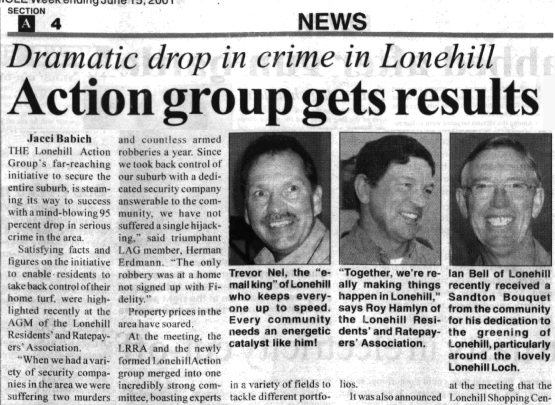
Due to the CONFIDENTIAL nature of many of my business consulting projects, I don’t often get to share the most important confirmer of an individual or business enterprise’s skills.. the TESTIMONIAL. Everyone in business should be collecting testimonials from people who are impressed with their service.
However, my own business projects and this community project allow me to share some of the many hundreds of testimonials that I receive regularly in my email inbox. For example:
- Testimonial: ‘Trevor Nel began the “Lonehill Security Project” in July of 2000. He witnessed one of South Africa’s most violent terror attacks which has resulted in one of S.A.’s most successful stories to-date. He decided to take on a 3000 strong community of residents in Lonehill to rise up and fight fire with fire. Residents still stand amazed at the results Trevor has achieved and the buy-in he has attained from the most radically negative and apathetic who today stand as allies in a most noticeable synergy. We all acknowledge the tremendous efforts put in by this one individual and today Trevor is a household name.’ Tony Henry – Chairman – Lonehill Residents Association 2001
- Testimonial: ‘I have had the pleasure of working with Trevor for over 4 years from mid-2000 to the end of 2004 in my capacity as co-director and, for the last three years, Chairman of the Lonehill Residents’ Association. The LRA has achieved results that are world-class in pulling together a community to manage its security and environment to a level with little or no peer. In under 5 years, the LRA has gone from a fairly typical residents’ association with little formal structure and limited means to an operation that now manages R1m a month, a security provider with some 230 people directly employed on the project, a full-time Estate Manager with a team of five gardeners, and a full-time administration service provider managing the infrastructure. A great deal of the credit for these achievements goes to the efforts of Trevor, whose vision and marketing dynamism have been major factors in driving the project forward. Trevor is clear and determined in his goals, and not one to let controversy slow him down.’ Chris Crozier – Chairman – Lonehill Residents Association 2002 – 2005
- Testimonial: ‘Dear Trevor, I would like to applaud your dedication to the cause and thank you for your untiring efforts to get the entire Lonehill community on board. Where would we be without you? My very best Christmas wishes to you and the LRA.’ Yours gratefully, Jennifer Clinton
- Testimonial: ‘Dear Trevor, I would like to wish you a very happy end-of-year and all the best for 2003. You have been such an inspiration to all of us throughout this year and I am sure there have been hard times for you but we really, really appreciate all your hard work and effort. Keep your spirits up.’ Kind Regards Cindy and Tony Maddison
- Testimonial: ‘Dear Trevor, Three years ago you made an undertaking and you have surely delivered “tenfold” in the face of much mindless apathy and resistance. When the LRA is finally set-up to administer and control the activities of the village the residents will have a real asset in their hands. You are a “giant” of a man, may the Lord continue to bless you and give you the strength you need.’ Love Gina.
Oh dear! Isn’t it strange? As I share the things I have done in business and community, I get all embarrassed and wonder if anyone really cares.
I can feel the RELUCTANT communicator in me kicking in again.
I know that it is really so simple to apply a myriad of PROFIT-DRIVERS to any business that can easily double the income stream of that business, but I also know that there are many who will ‘pooh-pooh’ what I have actually experienced in my own business projects.
Like everyone else ‘sensitive’ to criticism, I’ll need YOUR encouragement, motivation and support to keep me sharing MANY more of these simple PROFIT-DRIVERS for your business.
Let me know if this information gets you as excited about business as it does me. Do you like this information? If you are not sitting in my presentations just send me a mental message to keep me inspired.. 😉
Next, I will touch on the INCREDIBLE POWER and critical importance of cultivating Your Business Relationships… and why this single PROFIT-DRIVER can lead to your biggest pay-off for all your hard work.
Simple ideas to grow your business
How you can DOUBLE your business income potential ..and more!
Chapter 3. It’s Not What You Know..!
In this chapter I touch on the INCREDIBLE POWER and critical importance of cultivating Your Business Relationships… and why this single PROFIT-DRIVER can lead to your biggest pay-off for all your hard work.
GROWTH Profit-Driver No.3.
Your BUSINESS RELATIONSHIPS
After 30 years in business, I have come to recognise ONE critical reality above all others – the BULK of your business income flows from a small number of KEY business relationships.
On analysis I found that these are generally your BEST clients, your TOP suppliers, leading industry associates and close personal friends. They are all Top Performers who take an interest in helping you and your business.
I am reminded of the early ’90’s when I developed South Africa’s first-ever Protected Investment Fund – with ZERO downside risk..!
It was a no-brainer of a financial product developed from my studies of Derivatives Trading on the Chicago Mercantile Exchange in the late ’80’s.
In my simple-minded ‘highly-educated’ naivety (I spent a good couple of years in matric), I knew I had a winner for the banking sector.
All I wanted was for local banks to keep my local investors money SAFE in their vaults.
After all, what is a bank for, if not to keep our money safe?
Six months and SIXTEEN banks later, I realised that these bankers knew nothing about using derivative instruments, and therefore were unable to make a simple banking decision.
So, I shared my secret with a FRIEND.
My friend introduced me to his friend – a MERCHANT BANKER..!
Two weeks later we launched the fund which raked in MILLIONS in investor funds.. and traded over R2.1 BILLION in total transaction value in local derivative markets.
Not one of our clients ever lost a cent of their original capital invested..!
This fund was the forerunner of today’s myriad of GUARANTEED funds offered by most banks, albeit not as exciting as our original fund.. 😉
My own experience, coupled with insight into many clients, listed companies and friends businesses I have watched closely, is that often you can have or develop the greatest product or service in the world and still starve!
Look around you. Despite all the MBA’s, university degrees, business colleges, high-powered business consultants, and advisers.. why is it that only 4% of ALL businesses survive past 10 years?
Yes, that’s right!
Michael Gerber – author: The E-Myth – showed that 80% of all businesses fail in their first five years.. and 80% of the remainder fail in the next five years.
And, in South Africa, business is no different..!
The shocking truth for many – especially those academics armed with piles of theoretical economic textbooks – is that the REAL WORLD of business is NOT just about what you know.. but more often, who you know!
For me, the world of business is ALL about RELATIONSHIPS.
It is all about TRUST.
Decision-makers won’t do long-term business with you until they know you, get to trust in you, get to like you and/or RESPECT you, and get to feel that YOU really care about their needs too!
So here’s the point: if the bulk of business income flows from a small number of KEY business relationships.. what strategy do YOU have to INCREASE and develop your number of KEY business relationships?
Do you have a formal business NETWORKING strategy?
Do you meet regularly with other business LEADERS in YOUR inner circle?
Do you help them with new business leads.. and do they help you?
These questions led me to developing a formal business-networking forum to show business entrepreneurs just how exciting and advantageous it is to build your relationships in your own business inner circle.
The Inner Circle Business Forum – www.innercircleforum.com (now developed into www.fourwayscommunitychamber.co.za & www.facebook.com/fourwayschamber ) – is designed as the perfect base for building business relationships and sowing seeds of trust amongst your peers in your area – you just never know when you will need them!
Just ONE meeting a month is designed to deliver a multitude of immense benefits to every Business Owner, Director, and Decision-Maker.
I share with you our copy of the 14 good reasons for you to join your inner circle of business decision-makers and BUILD RELATIONSHIPS in your area:
Expand your customer base.
There are only three ways to grow a business.. one of the most critical of which is to find NEW customers.
Inner Circle members are potential customers for their business and personal needs, and key centres of influence in their families, communities, business associations, and church. They reach a lot of people and are an important source of referrals.
Keep yourself fresh.
Inner Circle members come from a multitude of business disciplines in varying industries and walks of life.
They may be LARGE listed company directors, MEDIUM-sized retail merchants, or SMALL business entrepreneurs.
Each has a unique perspective on business, and each has a unique strategy for generating profits in business.
Nothing is more pitiful than a bored business executive who has closed him/herself off solely to the dull, blinkered input of a limited market.
Increase the market value of your business.
Inner Circle members are by their very nature – the cream of the crop.
They represent potential financiers, venture capitalists, investors, shareholders, and stakeholders.
They have the potential to grow their businesses through mergers, acquisitions and joint ventures.
Sooner or later you may want to ‘cash in your chips’.
No business can be too complacent about the future.
It is easier to get financing and investment from people who know you and trust you than from parties you have to cold call, especially when a crisis hits – which it will!
- Invokes the Master-Mind Principle.
Napoleon Hill’s study of Andrew Carnegie’s secret of success revealed: ‘Economic advantages may be created by any person who surrounds himself with the advice, counsel, and personal cooperation of a group of men who are willing to lend him wholehearted aid in a spirit of perfect harmony.’
Napoleon Hill went on to suggest that: ‘No two minds ever come together without, thereby, creating a third invisible, intangible force.’
Carnegie’s Master-Mind Group consisted of fifty men as his Board of Advisers to whom he attributed his entire fortune.
- Multiplies the synergy of quality relationships.
Buckminster Fuller – America’s super-inventor, of Epcot Centre: Geodesic Dome fame – gave scientific meaning to Napoleon Hill’s claim: ‘A group of brains coordinated in a spirit of harmony will provide more thought energy than a single brain.’
Adapting Fuller’s formula for Synergistic Relationships (replacing N with P): (P2 – P)/2 = S (where P stands for the number of People in a group and S stands for the resultant potential Synergistic Relationships) – showed that 10 people at a table have 45 possible relationships, 100 people in a room have 4950 possible relationships, and 1000 people in a business forum have 499 500 possible relationships.
Inner Circle (now developed into www.fourwayscommunitychamber.co.za & www.facebook.com/fourwayschamber ) brings these multiple new relationships to you.. to capitalise upon.
- Mix with positive, passionate people.
Inner Circle members declare their desire to grow their businesses and profit.
They are passionate about what they do.
Their enthusiasm for life and business is uplifting and infectious.
All meetings are designed to provide insight to current business challenges and to stimulate input for profitable solutions.
It is a fact of life that you become like those you mix with.
Negative people are discouraged from joining and generally disqualify themselves by default!
- Facilitates transfer of ideas & innovations from industry to industry.
With the representation of many and varied industries and businesses, Inner Circle members are encouraged to share and discuss ideas and innovations in their industries that can be transferred into other industries.
Be first to test new ideas and innovations in your business ahead of your competition.
- Keep one foot on the ground.
All business leaders get sucked up into the day-to-day concerns of managing crises in their businesses.. this leads to myopic, insular perspectives limiting the scope of possible profitable solutions.
Inner Circle members are constantly reminded to get back to the basics of quality business principles by Guest Presenters, Panel Discussion Groups, Business Brief Collector’s Series – business development articles, Web Site links, and email alerts and reminders.
- Keep one finger in the wind.
Business owners need to be constantly aware of shifting market conditions to make instant decisions to ‘trim their sails’ or to aggressively ‘tack into the wind’ in keeping with their overall business strategy.
Inner Circle is an entire Research and Development ‘department’ for every business entrepreneur to keep his finger on the pulse of local market trading conditions, business confidence of peers, and to test-market and research customer perceptions of a potential new product.
- Keep one eye on the future.
Inner Circle members are kept abreast of new technologies, global economic conditions and rapidly changing markets through Guest Presenters, Business Briefs, Web Site and email alerts.
The entire format helps to keep you informed and in touch.
- Saves you time and money.
Nothing is more time consuming and costly than trying to break through the clutter and stonewalling built up around decision-makers whom you wish to contact and do business with.
From breaking through the disinterest of stony-faced receptionists, to playing the game of telephone tag and frustrating voice messages that never get returned, to breaking the firewall protection of your prospects PA.. you are no different to any one of the thousands of other sales-people that are trying to capture your prospect’s business.
Inner Circle raises your status amongst business decision makers as a peer, puts you directly in front of them, and creates an unwritten ‘brotherhood’-type obligation to hear your proposal.
- No beating around the bush.
Inner Circle members are encouraged to make decisions based on your input with the minimum of fuss and time wasting.
The Member’s Credo recognizes that every member is in business to profit and that every member’s time is precious.
Quick, informed decisions – whether YES or NO – become the aim and prized objective of all Inner Circle members in seeking to develop profitable business relationships.
Enormous value for money and cost effective.
Inner Circle members get access to some of the finest minds and insights in local business, direct business contacts, new business leads, ongoing education and update information.. all for the effective cost of a simple dinner.. or a single game of golf each month.
Each meeting is designed, in part, to impart information and business solutions that are presented in private consultations and seminars – priced in the thousands of rands.
You cannot afford to miss this ONE business appointment each month for fear of losing your entire year’s profits!
- One day you will need your inner circle contacts too.
Remember that one day you are going to need the best people in various businesses in your local area.. that you know and trust.
When you sell your home you will want a real estate professional you know and trust for the best deal.
When you invest your profits you will want a financial adviser you know and trust.
When you sell your business you will want the best business broker.
When you have a medical emergency in your family.. the best medical professional.
When you have a legal crisis.. the best attorney.
When you have a tax problem.. the best tax specialist.
When you want the best people that you know and trust.. you can turn to your personal contacts made in the Inner Circle Business Forum.
Phew.. quite a list. But, I must smile.. in this chapter is the key to making a FORTUNE through your business relationships, yet I know that only a FEW will have taken the time to read it.. let alone, apply the information.
Aaah well, that’s why only the FEW really succeed in life.. 😉
In my next chapter I will touch on Profit-Driver No. 4 – the importance of simplifying your Business Operating System, and give you the BEST WAY to ensure that your Procedures and Processes are systematised to allow your business to run, grow and profit while you are away traveling around the world.. 🙂
Simple ideas to grow your business
How you can DOUBLE your business income potential ..and more!
Chapter 4. Your Vending Machine System
In this chapter I touch on the importance of simplifying your Business Operating System, and give you the BEST WAY to ensure that your Procedures and Processes are systematised to allow your business to run, grow and profit while you are away traveling around the world.. 🙂
GROWTH Profit-Driver No.4.
Your BUSINESS OPERATING SYSTEM
For me, the process of a business is very simple to analyse at a glance.
Every business revolves around the flow of money from the consumer in exchange for value that the consumer expects to receive from the business.
To demonstrate how this money-flow process works, I provide my delegates with a very simple, extremely basic, series of slides, which to my constant surprise always seems to raise intense discussion and interest.
Slide 1.
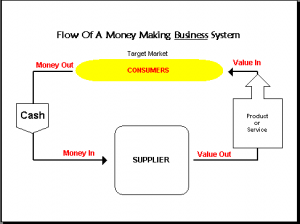
Every business functions around its ability to get the consumer to dip their hands into their pockets to pull out their hard-earned cash (Money Out) and to place it into (Money In) the hands of the business (SUPPLIER) in exchange (Value Out) for the product or service that will meet their need or give them what they want (Value In).
The Vending Machine Business System model is:
Money Out (Consumer) to Money In (Supplier)
Value Out (Supplier) to Value In (Consumer)
Break this cycle and you break the cycle of trust with your customer that ensures success for any business.
By way of analogy, I am sure that almost everyone has experienced the dreaded cold-drink vending machine at any airport around the world.
Here is the question I pose to my delegates at presentations:
Imagine stepping off a long, hard dry flight on a super-hot airport apron and walking past a cool-drink vending machine displaying frosty, ice-cold colas.. and you discover that you have just enough coins in your pocket for one of those enticing cans.. what do you do?
Of course! You dip your hand into your pocket and slip your only available coins expectantly into the vending machine.
What do you expect to happen?
You expect that tumbling, rumbling sound of an ice-cold can of cola to begin rolling down into the dispensing tray for you to eagerly pluck up, snap open, and throw the cool contents down your parched throat.
Slide 2.
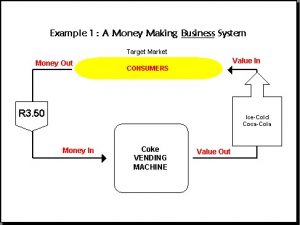
But what normally happens?
NOTHING!
Aaaah.. you’ve come across that vending machine too.. 😉
So what do you do?
You kick the machine, right?
With a little bit of luck you might get your money back.. well actually.. only if you are very lucky!
Now what happens when you next walk past that vending machine?
Will you put your money in?
Not blooming likely!
And.. that is the simplest way to describe the importance of your business operating system.
It must deliver the service the customer expects.
If it doesn’t, you will probably never get a second chance.
Let’s see how various business sectors can be described using this simple model:
Slide 3. The Cellular Communications Industry
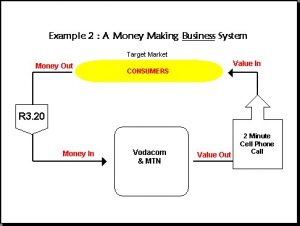
The money-flow process of a simple cell phone call is quite simple to follow using this model.
This slide serves to demonstrate the simple essence of the core value-exchange process inherent in many of today’s most successful revenue-generating businesses in the cellular communications industry.
The exaggerated point that I attempt to make here is that the value-exchange process of any business in any industry should be just as simple to construct.
Slide 4. The Newspaper Media Industry
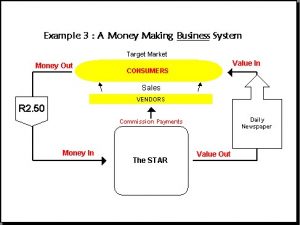
The Newspaper Media slide introduces the added process of distributing products and services through a sales force, which can include street vendors and stationery outlets.
The purpose of this slide is to demonstrate the introduction of an important third-party intermediary for most businesses in the money-flow process – the sales team.
This simple, graphic, informal flow-chart process can be easily created on PowerPoint and is a rewarding exercise for developing a heightened understanding of the money-flow process.
The key to this exercise is in ensuring that white space dominates the slide.
Allow as many people as you can in your business to build their impression of your money-flow process, and be ready for a surprise. Ensure that you take your sense of humour along for the duration of the exercise. You’re going to need it when you discover how others see your business.. 😉
Slide 5. The ‘It’s So Simple!’ Information & Action Program
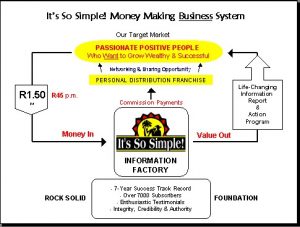
This ‘It’s So Simple’ slide demonstrates how I have used this simple model to show the money-flow process of a business, adding in the benefit statement of a ‘Rock Solid Foundation’. This came from another one of my own successful business projects – a publishing/distribution operation.
I have found this simple ‘vending machine model’ to be a very effective and fun way to remove all the unnecessary complexities to understanding what it is that a business really does to create an exchange of value for money.
It is the first step to understanding the critical importance of a Business Operating System.
I first learnt the importance of simplifying your Business Operating System back in the ’80’s while pioneering the growth of South Africa’s LARGEST private sector Education Franchise at the time – The Academy of Learning.
My experience gained in establishing 42 franchise education centres saw me being voted onto the Executive Board of the then South African Franchise Association (SAFA – now FASA) for three years, becoming an aggressive change agent for a new profile for FASA despite vigorous opposition to change from within.
I recall flying up to Johannesburg from Durban for three months, without my family, and almost living in the office for 90 days with the conviction to turn The Academy of Learning from a backyard-style start-up garage-business operation into a significant national player in the Franchise field.
What I saw when I arrived, both horrified me.. and excited me.
There was no business structure at all!
What a great opportunity!
I sourced and analysed information from some of the world’s leading franchise experts who were few and far between in an industry that was regarded, at the time, as something of a ‘pariah’ industry.
In fact, I did not know it at the time, but I learnt that the Franchise concept only survived being regarded as an ‘illegal pyramid scheme’ by 2 or 3 votes in the U.S. Senate.
Today, Franchising drives a BIG share of the world economy!
Two resource books inspired me into developing a simple Business Operating System: McDonalds – Behind The Arches (the story of Ray Kroc’s success in building one of the most recognised retail trademarks in the world), and Michael E. Gerber’s – The E Myth – Why Most Businesses Don’t Work and What To Do About It.
Gerber’s work, in particular, led me into developing a Franchise Prototype – a business operating system that allows you to clone your business and place it into the hands of others to operate and manage.
Effectively, a franchise prototype model allows you to develop a system that generates income for you.. even while you are not in the business.
Without re-inventing the wheel, I will refer you to two key areas of understanding that I gained from Michael Gerber and from which I continually look to apply certain elements to my own business projects as best I can:
i). Develop your business as you would a franchise prototype.
Gerber says that you have to ‘..pretend that you are going to franchise your business’.
He continues: ‘..pretend that the business that you own – or want to own – is the prototype, or will be the prototype, for 5000 more just like it. That your business is going to serve as the model for 5000 more just like it. Not almost like it, but just like it. Perfect replicates. Clones. In other words, pretend that you are going to franchise your business.’
Meaning, that regardless of whether you intend to franchise your business or not, you should design it as though you are going to franchise it.
Gerber proposes 5 rules for designing a quality franchise prototype:
- Assume that each business model will be operated by people with the lowest possible level of skill.
- Make the model stand out as a place of impeccable order.
- All work to be carried out in the model must be documented in Operations Manuals.
- The model must provide a uniformly predictable service to the end consumer.
- The model must utilise a uniform color, dress, and facilities code.
ii). Simplify and standardise your business operating systems, procedures and processes.
Gerber outlined ‘three distinct, yet thoroughly integrated activities: Innovation; Quantification; and Orchestration.’
Innovation: to make it as easy as possible for your market to buy and use your product.
Quantification: to develop the metrics (numbers, ratios) needed to record, analyse and adopt the most successful innovative changes and tweaks you make to every process in the business system.
Orchestration: where you take the results from the innovation and quantification and look for predictable patterns.
Perhaps the most worldly-wise observation Gerber makes is his opinion that the only thing predictable about people.. is their unpredictability!
Therefore the business system must ensure that predictable service will be supplied to the customer’s expectation, every time, or risk customers moving on to get what they want.. from your competitors.
Orchestration recognizes that humankind’s craving is for reason and predictability.
People do not like change!
Gerber states: ‘It is as simple as doing what you do, saying what you say, looking like you look – being how you are – for as long as that works. And when it doesn’t work any longer, change it’.
Quite right, you have to know what your customer wants or needs at all times and give it to them at an excellent price.
And, although people don’t like change, the world is changing all the time, so once you’ve innovated, quantified, and orchestrated, then you must be prepared to continue to innovate, quantify and orchestrate to keep your business at the top of your customer’s mind and ahead of your competitor.
Gerber also offers his own seven distinct process steps for developing your Franchise Prototype, which are well worth following in developing any business:
1. Your Primary Aim – deliberately formulated to reinforce the fact that the business is not your life. You are!
Your first priority is to develop a script – your personal vision – of what you would like your life to look like.
Then you plan how your business is going to help you achieve your objective on a day-to-day basis.
It is your purpose behind the business. Your WIIFM – What’s In It For Me?
It is the positive energy you will need to persist through all the negative influences you will come across as you grow your business.
Says Gerber, ‘..the difference between great people and everyone else is that great people create their lives actively, while everyone else is created by their lives, passively waiting to see where life takes them next’.
2. Your Strategic Objective – ‘a very clear statement’ of what your business has to do to help you achieve your personal vision in life. It includes:
– assessing what income your business needs to produce to help you achieve your Primary Aim;
– assessing whether a frustrated market exists that will happily purchase your solution to their needs;
– identifying what kind of business you’re in – (i.e. We’re in the business of changing people’s lives, and offering hope in the future);
– understanding your clients desires;
– designing your product to satisfy your clients’ needs;
– setting your targets and standards of performance.
3. Your Organizational Strategy – requires a very deliberate organizational hierarchy.
Each person in the organization needs to know exactly how they fit into the system to make it run smoothly in servicing the needs of the customer.
Each person in a quality organization services everyone else as a customer with needs.
4. Your Management Strategy – needs to be transformed from out of the hands of ego-driven people, who want control over others, into a system that is ‘designed to produce a marketing result’.
5. Your People Strategy – must take into account that people want to work to a clearly defined plan, a set structure, a well-conceived game plan.
As with any game it comes with some key rules, Gerber explains, such as:
– ‘Never create a game for your people you’re unwilling to play yourself.’
– ‘Change the game from time to time – the tactics, not the strategy.’
– ‘Never expect the game to be self-sustaining. People need to be reminded of it constantly.’
– ‘The game needs to be fun from time to time.’
In describing the game plan of an innovative hotel manager, Gerber discusses the importance of understanding the logic of the game. He highlights how this hotel’s service was built on the following logic:
‘Most people today are not getting what they want. Not from their jobs, not from their families, not from their religion, not from their government and, most important, not from themselves.’
‘Something is missing from their lives.’
‘Part of what is missing is purpose. Values. Worthwhile standards against which our lives can be measured. Part of what’s missing is a game worth playing.’
‘What’s also missing is a sense of relationship.’
People need people!
People need a purpose.
Gerber’s observations compare exactly with the most consistent observations that I have noted in every business system, concept or project I have established.
Gerber expands, ‘That’s what a business can do. It can become that place of community. It can become that place where words such as integrity, intention, commitment, vision, and excellence can be used, not as nouns, but as verbs, as action steps in the process of producing a worthwhile result’.
Man, this guy is good! I wish I had written that first. I believe this to be one of the greatest sentences I have ever read describing what a business can truly be: ‘..where words such as integrity, intention, commitment, vision, and excellence can be used, not as nouns, but as verbs, as action steps in the process of producing a worthwhile result’.
6. Your Marketing Strategy – is designed to place your customer first.
Gerber warns, ‘..what you want is unimportant. It’s what your customer wants that matters. And what your customer wants is significantly different from what you think he wants’.
What Gerber wants each business entrepreneur to begin researching is customer demographics, psycho-graphics analysis, commonality surveys, and what colors, shapes, and words to use when communicating with your customers. So you’ve got some homework to do in researching these areas.
7. Your Systems Strategy – Gerber defines a system as ‘..a set of things, actions, ideas, and information that interact with each other, and in doing so alter other systems.’
He demonstrates how the selling process can be structured into a system by developing:
- The Appointment Presentation.
- The Needs Analysis Presentation.
- The Solutions Presentation.
By developing such systems strategy you will not have an emotional person selling what they think the client needs. Rather the selling system will identify what the client really needs, and also what they don’t need.
Gerber wraps up his great book by stating: ‘A small business is a place that responds instantly to any action that we take. A place where we can practice implementing ideas in a way that changes lives.’
In other words, a business can be a place where a system brings order to people’s lives in an otherwise chaotic world.
But, will converting your business or idea into a Franchise Prototype really work?
Gerber reminds us of the old Chinese proverb that says: ‘When you hear something you will forget it. When you see something, you will remember it. But not until you do something, will you understand it.’
Until you actually apply the Franchise Prototype concept to your business you may never know just how successful your business can really be.
You may never know what it is like to have your business working for you, rather than you working for your business.
How do I know it works?
I have applied many of Gerber’s concepts to every successful business I have developed.
In my next chapter I will touch on Profit-Driver No. 5 – Your USP – what differentiates you, your business and your product from your competition?
Simple ideas to grow your business
How you can DOUBLE your business income potential ..and more!
Chapter 5. So What Makes You Unique?
In this chapter, I touch on Profit-Driver No. 5 – Your USP – what differentiates you, your business and your product from your competition?
GROWTH Profit-Driver No.5.
Your USP – UNIQUE SELLING PROPOSITION
Of all the business Profit-Drivers I focus on, this for me is the SIMPLEST, yet most profound!
Your USP is the critical HOOK upon which your entire business strategy and tactical processes will hang.
I well remember spending a number of WEEKS in intense creative brainstorming to convert the image of Academy Of Learning from a backyard garage-business concept into the LARGEST Education Franchise in S.A.
The first thing I did was to identify what it was that made us UNIQUE, what it was that would differentiate us from our competition, and what it was that would turn our brand and image into the ‘Coca Cola’ of school-leaver education in South Africa.
There’s your first clue:
Everyone recognises Coke’s logo and name, which leads their brand and image.
The trick is to try to incorporate your USP and brand name into your logo.
Then, lead with that into the marketplace.
People buy image, they buy a recognizable brand, as long as it genuinely delivers the expected benefits to them.
The Academy Of Learning’s new logo, brand and image adorned 42 national education franchise shop windows, was in every daily newspaper, appeared on national TV, and was processed on top of 80 000 graduation certificates which found their way in front of EMPLOYERS in just 18 months, before we sold out to a JSE-listed company.

As the old saying goes: A picture paints a thousand words.
So, a LOGO can convey the UNIQUE ESSENCE and image of your business in a simple VISUAL statement.
As I go through some of my own business concept developments, I find a consistent pattern of building the name of the business, or the business intention, into the logo.
Growth Holdings is my own business consultancy operation launched in 1990, and still going strong after 15 years.. a rare achievement for any business in today’s world of mass business failures.

The upward arrow element was taken from a natural arrow identified in my signature. The designer of the logo was an amateur graphologist. The concept fitted perfectly with my mission for this company: ‘To enhance the Creation of Wealth, Personal Growth & Development, and Quality of Life for all members of society who use, or are associated with the Services of our Enterprise.’
Richard Branson’s Virgin brand inspired me to play with brand extension in the development of the Growth Protected Investments logo. Through this innovative 100% money-back guarantee investment concept brand we traded over R2.1 Billion in total transaction value.. without any one of our clients ever losing a cent of their original capital invested.
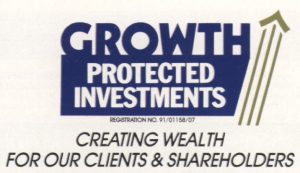
For me, logo development should be fun, and it should reflect your first personal gut feel idea of what you want to convey.
The It’s So Simple! Logo was designed to portray the end-result of applying the life-changing information provided in much of my writings.

If really smart, a logo can carry your SINGLE-MINDED PROPOSITION as a by-line.
For instance, incorporated into our attractive Inner Circle logo is the by-line – WE TALK BUSINESS. That, after all, is precisely what we do at Inner Circle.
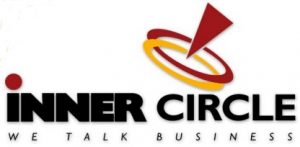
In one of my latest business projects we are currently toying with logo developments that look like this:
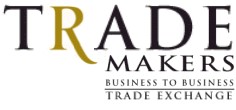
In an interesting business platform extension strategy we are experimenting with creating our own competition in the market with web logo developments that look like this:
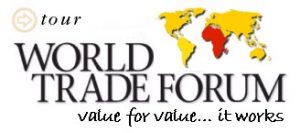
Let’s consider a few business logos and by-lines that I’d love to have initiated:
AVIS – We Try Harder
ABSA – Today, Tomorrow, Together
Coca Cola – Coke Is Life
Toyota – Everything keeps going right
Nike – Just Do It.
Note that the consistent by-line rhythm preferred seems to be that of three words to convey the WHOLE USP concept – another little clue!
For me, unless you can describe your USP in 60 seconds or less, you will probably never truly understand what really differentiates you from your competition or the general business ‘noise’ around you.
Bear in mind that ‘noise’ is what competes with you for your potential customer’s money.
I have discovered that if business owners and staff cannot articulate their USP in 60 seconds or less, it is unlikely that their potential customers can comprehend what makes them unique. So the battle is already half-LOST!
So what is it that makes you and your business UNIQUE?
Are you better, faster, tastier, bigger, less expensive, premium-priced for best service, and can you back it up with a 100% satisfaction guarantee?
What DIFFERENTIATES you from everyone else?
If you can’t find a USP, it may be time to redefine your business, or to repackage your product to include a NEW factor that is UNIQUE.
Then you absolutely must build that USP into everything you do to promote it.
In my next chapter I will touch on Profit-Driver No. 6 – Your MARKETING STRATEGY – the one area in your business that can generate the BIGGEST profits by making the smallest adjustments. I’ll explain how and why.
Simple ideas to grow your business
How you can DOUBLE your business income potential ..and more!
In this chapter I touch on the one area in your business that can generate the BIGGEST profits by making the smallest adjustments. I’ll explain how and why.
Chapter 6. Where The Big Profits Lie
GROWTH Profit-Driver No.6. Your MARKETING STRATEGY
Aaaah.. MARKETING..!
Everyone thinks they know everything there is to know about marketing their businesses, but most only scratch the surface of the HUGE potential profits available to us in this exciting area of business.
Peter Drucker – the Business Management guru of the ’70’s first emphasized to me that the purpose of a business is first and foremost to create customers.
His two key buzzwords that I fell in love with, and locked onto for life, were INNOVATION and MARKETING.
Why?
Well, as a budding young capitalist, Drucker impressed upon me at the time that these two functions – INNOVATION and MARKETING – are the only two functions in business that produce results. All the rest are COSTS..!
For one that was only interested in PROFITS, that was good enough for me.
I became a ‘master’ at INNOVATION, and am still constantly amazed at what I learn every day about MARKETING..!
Now here’s a whack on the side of the head for many South African business owners – a truly untenable comment that will annoy 95% of those doomed to fail in business.
Here it is: For me, the purpose of your Marketing Strategy is to put your customer FIRST.
It is to recognize that the Customer IS KING or QUEEN..!
Most of us ‘aggressive’ South Africans design our businesses from OUR perspectives and provide our products and service on a ‘take-it-or-leave-it’ basis.
And I am one of the biggest culprits, which is why I regard myself as an ever-learning student of marketing. It is my biggest weakness that I have had to focus on intensely for 30 years!
So what I have I learnt in that time?
Well simply, if you are honestly going to put your customer first, you’d better get to learn something about your past, present and potential customers.
For me, my first rule of business is to:
Find out what people want or need..
and give it to them at an excellent price
This rule applies to products or services that ADD-VALUE to society.. and that do not remove from it.
So, to me, Marketing Strategy is first about understanding your customer.
It’s all about customer demographics, psycho-graphic analysis, commonality surveys, and what colors, shapes, and words to use when communicating with your customers.
How much work do you do in researching these areas?
Marketing Strategy is, secondly, about reaching your target market with a message that pulls customers in to buy from you.
It is about PROMOTION, ADVERTISING, Direct Marketing, Presentation, all the theory available in 1000s of books!
But there is only ONE secret to marketing success..! TESTING.
For me the true marketing and sales ‘gurus’ insight that I have applied over the last 30 years have been from: David Ogilvy, Tom Hopkins, Tom Peters, Jay Abraham, Gary Halbert, Zig Ziglar, Dan Kennedy, and Wendy Evans.. to name a few.
And every single one gets you to TEST every element of your marketing efforts.
This is the one consistent failure of most South African businesses!
They throw their money at advertising and once-off marketing efforts and HOPE that something sticks!
They don’t analyse the response data.. and they don’t test different variables over time.
Testing different variables is critical, but who really applies it… less than 1 in a 1000 business owners that I’ve ever met.
But, perhaps the simplest and MOST PROFITABLE marketing insight I ever gained was from Jay Abraham, who pointed out the concept of UPSIDE LEVERAGE in business in a way that I could understand.
First he pointed out that there are ONLY THREE (3) WAYS to generate increased revenue into any business..
- ..by bringing in NEW customers;
- ..by adding value to your products and increasing their average selling price; and
- ..by getting your OLD customers to purchase more frequently.
This gives me a simple focus to begin with on every business I analyse.
Abraham also pointed out that MARKETING is the one area in business that has the biggest upside leverage potential of all.
He showed how most businesses can more than DOUBLE their revenue off the same fixed costs, in fact, he showed how to get a TEN-FOLD increase in revenue off the same fixed time, effort, opportunity and money costs spent by every business.
For instance, an ADVERT costs you the same fixed cost whether you pull 1 or 1000 responses, whether you close 1% of those responses or 30% of them, or whether they buy R1000 worth of goods from you or R100000 worth over the course of their LIFETIME with your business.
A SALESPERSON costs the same fixed amount whether they are doing 3 presentations a day or 10, closing 5 % or 50%, getting 1 referral or 5 per call.
Jay’s simple genius, for me, was to get us to question how we can INCREASE simple KEY RESULT RATIOS from every function of marketing that we can think of.. resulting in MASSIVE cumulative profit from the same cost base.
There are literally hundreds of innovative ways to apply marketing leverage to every business, which will lead to exponential growth and profit.
Almost always, in most businesses, I see only one or two applied with any degree of persistence in most operations, and with NOT much follow-up or analysis afterwards.
What a waste of effort..!
The simplest way, I learnt, to begin the task of developing a Marketing Strategy that works, is to do it by NUMBERS and PICTURES.
Ideally, get a huge map of your area you want to operate in, and break it down into numbers of prospective customers.
I did this when I went national with the Academy of Learning and mapped out every target municipality we were to open up in.
The objective was to convert the prospects into clients by following coloured pins on the MAP board.
Most WON’T do this!
Let me end this little insight with just SIX Key Reminders that I focus on for every marketing strategy I look into (of the hundreds and hundreds of simple tactics we can apply):
- Do I have a product or service that people want or need?
- Do I know who my customers and prospects are and where they are located?
- Do I know what they think of me.. my product/service.. my business..?
- Do I focus on the ONLY 3 Revenue generators in every business?
- Do I use the old standard – AIDA: Attention, Interest, Desire, Action?
- Do I TEST and analyse the results of EVERY marketing effort?
After 30 years, I know that I am a marketing ‘midget’ in terms of how much I learn, every day, about marketing.
There is just so much we can learn from other people in our own companies, from our competition, and from other industries.
Yet, it still amazes me that I apply so much more in marketing strategy terms than most businesses I see.. and they think that I am a ‘superstar’, a ‘genius’!
To me, it is just sheer marketing madness not to apply as much to THINKING about marketing strategy as we can.
The little things make BIG profits.
The trick is to look for people, and their businesses, who are genuinely successful in their marketing efforts.. and to borrow, ‘steal’, and adapt their ideas to your own business.
You can read 1000 marketing books, listen to all the marketing ‘gurus’ in the world, and you will still never learn the new technique that will work for you tomorrow unless you try it – test, Test, and TEST!
In my next chapter I will touch on Profit-Driver No. 7 – Your PRODUCT DEVELOPMENT PROCESS – and the myriad of combinations and variations you can adopt, by simple tweaking of your current products, to create completely NEW high-profit product lines!
Simple ideas to grow your business
How you can DOUBLE your business income potential ..and more!
In this chapter I touch on the product development process and the myriad of combinations and variations you can adopt, by simple tweaking of your current products, to create completely NEW high-profit product lines!
GROWTH Profit-Driver No.7.
Your PRODUCT DEVELOPMENT PROCESS
This is obviously still a critical part of your MARKETING mix.
But, I am constantly amazed at how people almost totally ignore thinking about any further development of their product once they have finalized its production.
For me, Product Development is a NEVER-ENDING process requiring constant tweaking and testing.
Let’s start at the beginning with a simple statement.
For me, Product Development begins with my one simple secret to business success:
Find Out What People Want Or Need…
and Give It To Them At An Excellent Price!
Master this call to research your market and you’re well on your way to business success.
Yet, most businesses I am called in to assess do almost zero in-depth background research to check whether there is a market for their product or service.
I have come to believe that this is because of our aggressive South African entrepreneurial arrogance (as I have demonstrated in abundance in my own businesses.. 😉 which has us designing our products on a ‘take it or leave it’ basis.
South Africans have, for years, been designing products to suit their business operational requirements and personal relaxation needs (golf, holidays, etc.) rather than for what their customers may want the business or product to do for them.
Hey, I don’t have a problem with that.. if you are a successful business operator (maybe that’s why some of us are so relaxed and well-tanned.. 😉 . But, if we are not happy with our business profits and growth, this can be a BIG problem.
There are, again, literally hundreds of ways that you can double your profits, and more, by just doing some simple tweaking of your product or service.
The critical question to ask yourself is:
‘What have I overlooked?’
Just some of the follow-up questions to this observation are:
Are there any new markets that I can test my product in?
Are there variations of my product that can open up new markets?
What will it look like in black, with a stripe, in a box, with a logo?
Can it be spun-off into product extensions, premium or no-label brands?
What can I combine with my product to enhance its appeal?
What type of person consistently buys this product and why?
Can I locate this common customer with relationships in other industries?
Can I franchise or license my product or system to others?
The trick, quite simply, is to take your product and turn it upside down, inside out, dismember it, package it in bunches, in pieces, bundle it with others, brainstorm its potential uses with OUTSIDER focus groups, with your customers, give it away as a back-end, use it to upsell into a new range, link it to a product line in a completely unrelated industry, dress it up, add a NEW flavour, taste, colour.. just make certain that you do something BEFORE you decide to do nothing.
However, if you are making a FORTUNE with your product, for goodness sake, don’t fix what’s not broken!
Then you can afford to do what most businesses do once they have developed a product.. do NOTHING more with it.. 🙁
But, if you could do with some more income and profit, BREAK IT and fix it into something NEW and exciting.
You never know what it can turn into.
Remember that 3M’s super-successful Yellow Post-It Note was a researcher’s failed glue mixture.. given a subtle twist!
What the heck, at worst, it makes business FUN.
In my next chapter I will touch on Profit-Driver No. 8 – Your SELLING PROCESS and touch on the basic fundamentals used by TOP-Selling Pro’s to generate BIG REVENUE income… consistently!
Simple ideas to grow your business
How you can DOUBLE your business income potential ..and more!
In this chapter I touch on the selling process and discuss the basic fundamentals used by TOP-Selling Pro’s to generate BIG REVENUE income.. consistently!
GROWTH Profit-Driver No.8. Your SELLING PROCESS
Selling! The one simple process that leads to the biggest downfall in most businesses.
Without sales, you have no revenue.
Stay without revenue for too long, and pretty soon you ain’t got no profit.
So why do most businesses suck at the sales process?
It is because most sales-people suck at sales!
I have enough books on my shelves by world-renowned sales trainers, and have been to enough sales-training programs, to know that the process of sales is more than adequately covered for anyone who wants to make a fortune in sales.
There are literally tons and tons of books, courses and information available to anyone with the desire to master the selling process. I look at my shelf and see endless books, tapes and interpretations of respected sales masters like:
· Sun Tzu – ‘Art of War’ adapted to ‘Strategies for SELLING’;
· Tom Hopkins – ‘How To Master The Art of Selling Anything’;
· Zig Ziglar – ‘Ziglar On Selling’;
· Rank Xerox – ‘Professional Selling Skills System’
These books and courses will take you through all the key sales skills (and their infinite variety of nuances, tips & techniques), such as:
1. Prospecting
2. Presenting
3. Listening
4. Handling Objections
5. Closing
6. After-Sales Service
But what do I find when I meet sales people in many different businesses?
Most sales people I meet have never read a book on sales that they have personally sought after for themselves.
Most have only ever received ‘sales’ training through the list of companies that they have joined and left, and joined and left, and joined and left..!
And now they are in your company waiting for you to ‘train’ them!
Waiting for you to make them a fortune!
Most sales-people I meet hate what they are doing.
They think that their clients suck for not buying their useless product and that their company is ripping them off by not paying them a salary.
Show me a sales-person looking for a salary and I’ll show you someone in need of a cushy job.
Now don’t get me wrong. I don’t dislike sales-people – I am one!
I dislike what unmotivated, disinterested sales people are doing to disrupt quality businesses.
So, for me, the first step in the SELLING PROCESS is to find someone with the DESIRE to be a super-star in sales.
Leave the sales-training to some other company to cover in their costs.
Find someone that sells you first on the reason why you should take them on. Not the other way around.
A sales person looking for a new job is a warning sign in itself.
If they weren’t successful, making tons of money in their previous position, what’s going to make this time different?
If they can’t sell you on themselves, how are they going to sell your product?
Let them sell you on gaining the biggest slice of commission for the volume of business they bring in. Let them get wealthy by making you a handsome profit.
Let them sell you on your product and what they believe they can do with it.
Give them time to go away and do some research on your product and your competitors and let them come back and sell you on why you and they are the best combination to go to market.
Let them sell you on their personal benchmark for assessing whether they should stay with your company or not. Let them set the targets for staying or moving on.
Then give your sales super-star the freedom to make MASSIVE things happen.
The first 30 to 90 days are the critical indicators for any new sales-person. The pace they set in these early days gives a clear indication of their ATTITUDE to sales.
Should nothing significant happen within the first 90 days that indicates massive effort and innovation being applied by the sales-person, chances are they are not going to bring in the sales you need over the long haul.
The second step in the SELLING PROCESS that I look for (apart from the obvious sales skills) is an emphasis on analysing simple numbers – RATIOS.
One thing I know about using numbers in business is this:
ACTION leads to RATIOS.
RATIOS stimulate more ACTION.
For me, the biggest problem experienced by most businesses is getting their sales-people out from behind their desks and into the marketplace.
I’ve always smiled at Tom Hopkins’ description of this as the GOYA process – i.e. Get Off Your Butt.
Here are some simple questions that you can ask to stimulate the ACTION – RATIO – ACTION cycle:
· How many prospects do you need to contact per day?
· How many contacts result in quality presentations?
· How many presentations lead to a sale?
· What is the average value of a sale?
· What happens when I apply variants to these numbers?
There are endless combinations of simple numbers that can produce telling ratios pertinent to analyzing any business.
· How many calls does it take to close a sale?
· How many personal visits and marketing contacts does each customer need?
· How much does it cost per sale.. per different customer segment?
· How much time needs to be spent on calling on new prospects?
· How much time needs to be spent on calling on current customers?
· What is the optimum number of sales calls per day per salesperson?
· What is the optimum duration per sales call?
Oooh.. numbers are so exciting!
Working the numbers into an aggressive sales-activity strategy is a simple way to ramp up revenue in most businesses.
Bear in mind that every business is unique requiring innovative formulations of numbers into ratios specific to your business.
Do you and your sales-people know the simple numbers needed to be successful in your business?
Have you analysed what numbers your most successful sales-people work to and have you used this as your base foundation for everyone in your sales team?
In my next chapter I will touch on Profit-Driver No. 9 – Your PEOPLE PROCESS and how this process can have a massive impact on the performance of your business.
Simple ideas to grow your business
How you can DOUBLE your business income potential ..and more!
In this chapter I touch on how your people process can have a massive impact on the performance of your business.
GROWTH Profit-Driver No.9. Your PEOPLE PROCESS
Aaaah… PEOPLE..!
Can’t live with them.. can’t survive without them!
PEOPLE are the brains behind every facet of your business.
They are responsible for innovating, creating and managing almost all of your business profit-drivers.
Ask any successful business leader what the primary driver of his or her business is, and they will say: ‘..our PEOPLE..!’
Ask any beleaguered business owners and managers where they believe their biggest problems lie, and they will say: ‘..our PEOPLE..!’
The simple truth in business is that your PEOPLE will either stimulate significant profits in your business… or, incur crippling costs.
Your PEOPLE will make you or break you!
The question is, do you and your PEOPLE know which side of the equation they are contributing to in your business, and are you and they happy about this contribution?
And, if not, what are you going to do about the situation?
You see, business leaders are instinctively aware that their people are the very core of their business, which is why business spends a fortune on hiring specialists in motivation, education and training for their people.
But does it work?
No!
World-leading consulting guru, personal friend, and business associate – Tom Lambert – Chairman of the International Centre for Consulting Excellence and author of 10 best-selling business-books, including the industry standard – ‘High Income Consulting’ – asks CEO’s and MD’s this simple question:
‘How much did you waste on training last year?’
Explains Tom: ‘The simple fact is that reliable research shows that training that delivers an acceptable business return on the investment is as rare as hens teeth.’
Tom quotes the work of Bruce Joyce of the University of Columbia, New York who showed: ‘Through careful detailed analysis.. that of the content of any training program, the average that is transferred to the workplace and applied is a meagre <5% to 13% according to the methodology used’.
Tom expands on the apparently hopeless inadequacy of most training attempts in business: ‘A study by Xerox showed that of that scanty transfer 87% is lost within 12 weeks if learning is unsupported. Putting that into financial ROI for the average training program, it is a little under 2%’.
Bear in mind that Tom’s business is.. ‘Training’!
Is he nuts?
No!
As a world-leading business consulting guru, not for nothing is he known by the world’s media as ‘the consultants, consultant’ and ‘the world’s friendliest guru’.
Tom recognizes what I know from many years in business: Training works… if you make it work!
To me, Tom’s success comes from identifying that training can be a powerful tool when you provide your people with specific objectives – a clear focus for their work process within the business strategy – and making them personally accountable for implementing their systems and activities in partnership with their peers.
Concludes Tom: ‘If you treble the revenues and profits of a firm within a year through training.. the price is a small one to pay’.
A simple clue for any business leader looking to increase their business income potential.. provide the right training for your people and PROFIT.
But, how do you get to know what is the right training to apply in your business?
Simple.. you don’t!
In all my years of analyzing business I have made one simple observation:
It is much easier to see the problems in someone else’s business or department than in your own.
Any business consultant worth their salt will tell you that they can almost identify the cause of most business problems within a matter of hours, simply by observing people in the business and asking the simplest of questions.
Why is this?
Why is the business-leader, the business-owner, the departmental manager et al not able to see where potential problems may lie in their business as quickly as an outsider, and therefore apply possible solutions to improve their productivity and profit?
It is all to do with emotions, egos, internal politics, perceptions, relationships.. all the little cultures and irritating people things that build up internally in a business over a period of time.
How do you question the process created by the one who hired you.. without fearing for your job?
How do you fire the employee you hired without being embarrassed over your selection process?
How do you expose the debilitating shortcomings of your office colleague without being accused of stabbing them in the back?
The outsider has none of this internal baggage when making their observations.
As an independent business consultant I have never been too shy to ask:
Why do those two customer service representatives sit behind their desks talking about the movies when the phone has been ringing for over a minute?
Why does your receptionist keep answering the phones without acknowledging the presence of visitors at the counter?
Why does your credit control department have so many piles of unkempt paperwork on their desks with a debtors book running to over 120-days?
Why does your sales team spend so much of their day behind their desks?
Why does your office staff park in the front of the building, forcing your visitors to park outside?
Why do your people not talk to each other without raising their voices and complaining about individuals and flaws in the system?
All are examples of simple observations that can be seen by the outsider, and all clear symptoms of a variety of potential business problems.
Yet, it is almost impossible for someone within the business to see, because they have become accustomed to the internal cultures and practices within the business.
That’s why independent business consultants have an important role to play in unveiling potential solutions to most business challenges.
Most certainly, the great consultants don’t have the same emotional baggage at play around the process of their client’s business.
The great consultants are not afraid to ask the critical questions, such as:
Are these expenses necessary?
What return do you get for your money spent?
What is your ROI (Return On Investment)?
Do you know what percentage profits you are making compared to the capital employed in your business – your ROA (Return On Assets)?
Do you use the ROAM model (Return On Assets Managed) to sweat your assets?
What are your average Debtor Days?
What can you be doing differently in your area of management?
These are the questions that thrill professional business consultants.
They love to help their clients make more profits, and they know that the simplest way to do that is to measure for results and keep score of critical ratios and percentages as internal and external yardsticks.
Again, let me remind you that no two businesses are ever the same, and therefore measurements need to be developed that are unique and meaningful to your business.
What should you be looking for?
Look for alternative ways to reduce costs, unnecessary expenses, inventory stockpiles, and unproductive people or machinery downtime.
Look for ways to increase productivity, performance and sales.
The unique numbers and combinations that make up a business never cease to amaze me.
Never being a master at maths, I still marvel at the fact that a simple 20% increase in training plus a 10% increase in production plus a 15% increase in sales activity plus a 25% increase in sales plus a 10% reduction in costs can lead to a 200% increase in profits (20+10+15+25+10=200).
Lest my old maths teacher sets out to find me to rap me over the knuckles again, it is clearly the MULTIPLIER effect of all these little improvements in the different areas of your business that can lead to massive profits.
There are literally dozens, if not hundreds, of different areas that you can focus on to deliver increased bottom-line profit to your business.
That’s what makes business fun!
Your PEOPLE should be aware of how their individual performances impacts these numbers and for what measure they are personally accountable.
That’s where independent business consultants are indispensable for analyzing and recommending quality training to suit your unique business needs, and to make it fun and productive for your people.
But perhaps the most important observation I can offer on the PEOPLE PROCESS is to suggest that, just as no two businesses and their problems are ever the same, so too are no two people and their life circumstances ever the same.
Each and every person you will ever meet and employ in your business.. is UNIQUE!
And they each come from a background of past and current circumstances in their lives that make their future actions impossible to predict.
In my experience, there is nothing more complex than the individual human being.
Throw two of them together and you have a myriad of complexities that can arise.
As you add more people to the mix, the potential complexities multiply exponentially until you have the powerful destructive force of a tsunami, hurricane, tornado and lightning storm.. all rolled into one!
Harness this wild force into positive, passionate, focused action and nothing will stop your business growing.
The biggest challenge for business leaders is that you just never know how different people will react or respond to any given situation.
Sometimes the only way to find out is to throw them in at the deep-end to see whether they sink or swim.
Oh boy.. I can just sense all the HR specialists and college professors throwing their hands up in despair at my gall.
I just tell it as I see it.
I’ve been there, done that and got thousands of well-worn T-shirts!
So, here’s a simple secret that can have a massive impact on your business profits:
Find a way to throw your people into the water to test them BEFORE you employ them.
Take a cue from the reality program ‘The Apprentice’, featuring Donald Trump.
Find people who want to IMPRESS you!
It’s all about finding positive, passionate people who are truly optimistic and who believe totally in their capabilities.
Such people are not looking for jobs, they are looking to grow and experience life with a desire to make a positive impact in whatever they do.. no matter what their function is to be in your business.
These people openly demonstrate the characteristics of leaders, they come with a track record of achievement, no matter how small, that they are justifiably proud of.
They have a positive self-expectancy and have no problem accepting a challenge to show what they are made of.
Clearly what I am suggesting is that the people process in any business is very much an inexact science. People are the great-unknown factor.
This brings the concept of LEADERSHIP to the fore.
My thinking on LEADERSHIP is based very much on practical personal experience, and is a hybrid of the works of many management gurus that I have had the pleasure of reading.
I find myself somewhere in the middle of the Hersey & Blanchard Situational Leadership model, Steven Covey’s Principled Leadership value-driven model, Tom Peter’s ‘Pursuit of WOW’ proposals, and Zig Ziglar’s discussions on WIIFM (What’s In It For Me) in ‘See You At The Top’.
Before I illustrate just how flexible a business leader has to be, I continue to highlight my opinion that almost every situation one encounters in business is unique, and it almost always has something to do with the people in that situation.
Sometimes I find that people in business are just not ready or mature enough in their own personal growth and business development to take responsibility and accountability for creating WOW Projects in the Tom Peters mode.
That’s when I find myself reverting back naturally to the Hersey and Blanchard Situational Leadership model.
The trick in this model is to find the correct balance between applying necessary supervision to match the employee’s skill and knowledge level, with that of allowing the correct level of support and encouragement for the employee to take personal responsibility and accountability for making things happen.
Back in the mid-‘80’s, when I was building the Academy of Learning into the largest education franchise in Southern Africa, I was working with fresh varsity grads and over 40 new business entrepreneurs who had paid a small fortune (from their perspective) to follow our business system in their franchise areas.
Whilst my own objectives centered around designing a WOW business project (as later described by Tom Peter’s in the latter ‘90’s), I found myself having to begin by carefully DIRECTING staff and franchisee behaviors by laying down fairly strict, but simple, franchise systems, rules and regulations.
My fresh, young varsity grads were given on-the-job COACHING in implementing these systems, and they were impressive in learning on-the-job by themselves as they coached the franchisees in these simple systems needed to run a profitable business franchise.
There is no better way to learn than by doing.
Before long our franchisees were experiencing nothing less than a 5- to 10-fold increase in monthly profits, and more.
The franchisees thought that our varsity grads were geniuses!
As soon as we could see that our franchise business system was being implemented in practice (within the first 3 to 6 months), we were able to step back into developing a SUPPORTING & DELEGATING role for our head office function.
We developed daily contact routines, weekly stats & analysis feedback reports, monthly newsletters, quarterly franchise get-togethers, and the mother of all annual conferences.
In the year of selling out my holding and management control to a JSE-listed company, our brand was recognized as one of the leading franchise brands in the country, with one of our new operators scooping the franchisee of the year award in the early ‘90’s for profitably applying our systems.
As an example of a very different experience in leadership styles, in 2000 I initiated what has now come to be feted as the most successful open community security initiative in South Africa – a project today valued at over R70 million and growing (Ed’s note: by 2019, having re-directed over R1 billion in security spend through the community security project).
Given no hope of success by the doomsayers, I had to bring together an apathetic, fearful community of homeowners who were being terrorized into submission by AK-47 gun-toting criminal gangs.
I developed my own version of Tom Peter’s WOW project, turning it into a personal, passionate, purpose-driven objective that I would not allow to fail.
My simple motto was, we are going to draw a line in the sand that evil criminal elements will not dare to cross.. you either join me to lead, follow, or get out of the way.
Tom Peters is 100% right when he says: ‘..if your project is genuinely a Wow Project, don’t doubt that you’ll have enemies. (Project axiom: Anything worth doing makes the establishment mad.)’
I made some people pretty mad!
However, within 3 months we had almost totally eradicated violent crime in our community, implemented an incredible, innovative security solution never-before-achieved in an open community in South Africa, and witnessed a dramatic jump in our property prices.
But, I could not have achieved this without getting the WIIFM (What’s In It For Me) buy-in of the majority of residents. So I had to lace my own WOW project ideals with a strategy that would sell them on the benefits of working together in a mass-consumerism project that is now into its fifth year.
That’s a full story in itself.
It worked!
A different project, an innovative approach, massive effort.. another successful outcome.
In essence, I believe that the success of your business, your department, your project, will depend on the LEADERSHIP example you set for your people.
Your success will depend on how you INSPIRE your people to give of their best.
They in turn will display leadership qualities of their own to those under their management and to the conduct of themselves in your business.
In my talks around the country I make an impassioned plea wherever I go, which has this message:
‘Yes, what our country is desperately in need of is.. Leadership.
‘True leadership!
‘Leadership at all levels of our society.
‘Leadership that recognizes that talk is cheap, and that actions speak much louder than words.
‘Leadership that recognizes that we are living in a world of transformation, a world of change, a world where people want to be treated like human beings.
‘Leadership that does not seek to dominate others.
‘Leadership that recognizes that true power and respect comes only from making a difference in people’s lives. Not by ruining people’s lives.
‘True leadership seeks to make a difference without ruining other people’s lives!
‘So, what is this thing called leadership?’
In seminars I go on to discuss what I believe to be some of the important characteristics of LEADERSHIP, being :
1. Leaders consider their own priorities first and foremost
2. Leaders consider the priorities and dreams of others
3. Leaders create a clear vision and purpose for like-minded people
4. Leaders are innovative, creative and persistent
5. Leaders are immune to criticism, crisis, rejection and failure
6. Leaders maintain a sense of stability and security
7. Leaders are optimistic about the future
8. Leaders take responsibility
9. Leaders develop plans, set goals, and actually work them
Leaders are often the most complex of all people, filled with all manner of paradoxical quirks and behaviors, and the most successful seem to recognize and respect these same complexities in others.
Leaders recognize their power of influence and almost always lead the way in taking action to make things happen.
The secret then to getting people to take action in business is to get them to take personal leadership over their process in the business.
In my next chapter I will touch on Profit-Driver No. 10 – Your CAPITAL RESOURCES and how you can uncover an abundance of possibilities by building your knowledge base in this area of business.
Simple ideas to grow your business
How you can DOUBLE your business income potential ..and more!
In this chapter I touch on your capital resources and how you can uncover an abundance of possibilities by building your knowledge base in this area of business.
GROWTH Profit-Driver No.10.
Your CAPITAL RESOURCES
Trusted friend and business colleague – Mark McClue – shares a fantastic presentation at our INNER Circle Business Forum meetings which he titles ‘Business Expedition Planning – Business lessons from an international white-water kayaker’.
Mark – a UK citizen who fell in love with the bush and rivers in South Africa – describes himself as a Mentor Capitalist & Business Incubator Specialist.
In his presentation he likens the ‘business process’ to that of planning an international white-water kayaking expedition to conquer challenging rivers.
He makes one key statement in his presentation that, for me, identifies that he has truly paddled the ‘river of life’, particularly in business.
Says Mark McClue: ‘In a world of capital abundance, raising capital is not the problem’!
For entrepreneurs in desperate need of a funding solution to keep their ideas or business alive, this comes as something of a shock.
I have to suppress a little giggle to myself as I watch the new, inexperienced, budding entrepreneurs, and the many experienced corporate business people who should know better, all begin to squirm in their seats as Mark shares his experiences in mentoring businesses.
He talks of all the failed business projects by entrepreneurs who believed that their ideas would fly ‘if only’ they could raise the seed capital from some divinely inspired angel investor who would just ‘trust’ in them.
Whenever anyone laments their lack of capital to launch their business ideas, I am always reminded of the profound words of author Dan Kennedy – something of an eccentric genius in the field of Direct Marketing and Advertising and highly regarded in the United States as a Business Consultant and Seminar Speaker.
Writes Dan: ‘If you can’t make money without money, you won’t make money with money either’.
Mark McClue follows this line of thinking as he dissects the value of a business idea and how such idea meshes with the elements of human capital, intellectual capital, financial capital and social capital to attract the attention of customers and capital markets.
As he discusses the difference between raising loan capital from a bank versus raising equity capital from private or public investors, I can’t help but feel deeply sorry for growing entrepreneurs who find themselves unwittingly dumped into a muddy pool of knowledge incompetence.
Here’s the simple truth about what is going to happen to you in business:
Sooner or later you are going to come up against an obstacle or challenge that exposes a gap in your knowledge.. especially in the areas of human capital, intellectual capital, financial capital and social capital.
Let’s consider a few definitions sourced from the ‘Net:
Human Capital – ‘the knowledge, skills, and abilities that allow individuals to produce goods and services’. InvestorDictionary.com
Intellectual Capital – ‘a term with various definitions in different theories of economics. Accordingly its only truly neutral definition is as a debate over economic “intangibles”. Ambiguous combinations of instructional capital and individual capital employed in productive enterprise are usually what is meant by the term, when it is used to actually refer to a capital asset whose yield is intellectual rights’. InvestorDictionary.com
Financial Capital – ‘or economic capital, is any liquid medium or mechanism that represents wealth, i.e. other styles of capital’. InvestorDictionary.com
Social Capital – ‘the social capital of a society includes the institutions, relationships, attitudes and values that govern interactions among people and contribute to economic and social development. It includes the shared values and rules for social conduct expressed in personal relationships, trust and a common sense of “civic” responsibility that makes a society more than a collection of individuals’. Worldbank.org
Phew.. I go ga-ga just thinking about the probable tens of thousands of volumes of publications and theories written on each one of these areas critical to business.
It all just confirms for me that there is not a businessperson around today who knows everything there is to know about business. Period.
Sooner or later, if you intend growing a significant business, you are going to require specialist advisors to help you fill that gap in your knowledge.
One way to fill this gap is to hire in specialist business consultants, which I totally recommend – as a professional business consultant of course.. 😉
The primary benefit offered by a professional business consultant, for me, is their ability to take an independent, unemotional role in opening up their clients minds to alternatives, to new possibilities, to question basic assumptions, to other ways of looking at and doing things.
Professional business consultants are, to my mind, privileged analysts of those in business who learn things the hard way through the school of hard knocks. They specialize in observing and learning from the experience of others mistakes.. and successes!
The truly great business consultants are able to take their wealth of experience and lead their clients to the knowledge needed to discover or develop innovative solutions and alternatives unique to their business.
Okay, enough already of my vested interest in the enormous value of using quality consultants.
Let me share with you two simple ideas that I use to fill any knowledge gap I may have in my own business thinking.
Build Your Own Dream Team of Advisors
Many years ago, as I entered business, I found the process of attaining knowledge from people who were actually successful in business to be a fruitless task.
I just couldn’t get in front of enough truly successful people for long enough to pose all the questions I had.
Strangely, as I look back, the business-people that did give me their time were either super-critical of my ideas.. or of me.
Or so I thought in my younger days.
I recall receiving largely unwelcome negative feedback from many, and as I got closer to them, their approaches to business just served to confuse my young growing mind.
I can count at least five such people who had the outward appearances of being influential and successful in business, and who ended up in prison or skipping the country for their serious misdemeanors in business.
As I think about it, the process of becoming successful in business, for me, was a very lonely business. There were too few of my sporting peers who were as interested in the basic science of business as I was at the time.
So I began to stick my nose into the publications of business people who were feted by the world as being successful in their fields.
I read literally thousands of books, magazines and special reviews to dissect what they were doing in their businesses.
Pretty soon, I began to treat these individuals as my ‘invisible counselors’.
Idea 1. My ‘Invisible Counselors’ Dream Team
I began asking myself: ‘What would X or Y do in this situation?’.
I remember developing an imaginary Board of Advisors, a DREAM TEAM of the people I admired most from their autobiographies and writings on life and business.
I would take my ideas and challenges, close my office door, and pose my questions to each of these ‘advisors’.. and then search their publications for consistent answers to each challenge I had.
Each of this ‘Dream Team’, to qualify, had to have shared at least ten impressive principles in their books that I was to learn and apply for myself in the expectation of them having a massive impact on my life and business decision-making.
I must warn you about one thing that I have learnt about putting people on pedestals.
No one, but NO ONE, is without flaws of their own, or a bevy of critics.
In almost every instance of selecting someone whose principles make me think, I have also found much negative criticism doing the rounds, to varying degrees, of many of those same individuals.
So, my only advice is to extract the good principles from such individuals that you can apply in your life and business, the ones that really get you thinking.. and ignore those weak flaws in their personalities that do not appeal to you.
It is your life and you are totally unique. Keep it that way.
Here are some of the people who have served on my board of ‘imaginary counsellors’ (some of whom I have since had the pleasure of meeting personally) and a short-list of just three quotes from each.. from whom I have learnt and applied their insights in my own life:
Zig Ziglar – Author, Public Speaker and Chairman: Zig Ziglar Corporation:
1. ‘With persistent physical, mental, and spiritual effort you can learn the skills you need to develop to reach your objectives.’
2. ‘You are rare, you’re special, unique and important. You can make a difference in the lives of others.’
3. ‘You can get everything in life you want, if you help enough other people get what they want.’
Bill Gates – Chairman and CEO: Microsoft Corporation; world’s richest man:
1. ‘Success is a lousy teacher. It seduces smart people into thinking they can’t lose. And it’s an unreliable guide to the future.’
2. ‘Entire industries and professions will fade. But new ones will flourish. This will be happening over the next two or three decades.’
3. ‘The economy is a vast interconnected system in which any resource that is freed up becomes available to another area of the economy that finds it most valuable.’
Nelson Mandela – Political Leader and Nobel Peace Prize Laureate:
1. ‘I have walked that long road to freedom. I have tried not to falter; I have made missteps long the way.’
2. ‘I have discovered the secret that after climbing a great hill, one only finds that there are many more hills to climb.’
3. ‘I learned that courage was not the absence of fear, but the triumph over it.’
Anthony Robbins – Peak Performance Coach and Super Consultant to world leaders:
1. ‘One idea. That’s all it takes to change your whole life.’
2. ‘Information is power when it is acted upon.’
3. ‘The most powerful way to shape our lives is to get ourselves to take action.’
Warren Buffett – Chairman of Berkshire Hathaway; world’s second wealthiest man:
1. ‘It takes twenty years to build a reputation and five minutes to ruin it. If you think about that you will do things differently.’
2. ‘I’d rather have a $10 million business making 15 per cent than a $100 million business making 5 percent.’
3. ‘What is one really trying to do in the investment world? The end is to come away with the largest after-tax rate of compound.’
Peter J. Daniels – Australian Billionaire:
1. ‘Do not allow anyone to destroy your dreams.’
2. ‘All business ventures are risks and if you are not prepared to accept risks then you have automatically removed yourself from the pathway to success.’
3. ‘As long as we obey the laws of God and respect the rights of our fellow man, we can do whatever we want to do and go as far as we want to go, and our only limits are those we place on ourselves.’
Edward de Bono – Master of Creative Thinking; Author and Super Consultant:
1. ‘Making ideas work is every bit as important as having the idea in the first place.’
2. ‘Successful people do not stand still and expect things to happen to them. They take a step and then the next step.’
3. ‘Credibility is in many fields a huge capital asset’.
David Block – Professor Applied Mathematics and Astonomy – Witwatersrand University:
1. ‘The universe has to be as large as it is just to support life on earth.’
2. ‘All science is based on the tenet of rationality. The entire universe is a rational plan of the Creator, who has designed the cosmos, 15 billion light years across, as a home for spiritual mankind.’
3. ‘We are significant here and now because we are the focus of creation.’
Paul Pilzer – visionary economist and author:
1. ‘Wealth is unlimited because it comes from our minds.’
2. ‘Imagine a need and create it.’
3. ‘Technology today is what makes one individual’s earnings power a thousand times that of another.’
Tom Lambert – CEO: International Centre for Consulting Excellence; author of 10 best-selling business books and Professor of Consultancy.
1. ‘We have a rapidly changing world in which the only certainty is change.’
2. ‘The growth of consultancy will outstrip the 20 per cent per year it has averaged in the US and Western Europe over the last 20 or so years.’
3. ‘The key to success is to be able to market your knowledge.’
Tom Peters – Super Consultant and world-renowned business book author:
1. ‘Made anybody angry lately?’
2. ‘WOW Projects = Changing the rules. Changing the rules = Piddling off members of the Establishment.’
3. ‘You will, simply, have to deal with people who, for various reasons, don’t want you to succeed: people who are envious, people who feel their turf is being invaded, people who have a b-i-g stake in the status quo, people who are just plain afraid of change.’
Robert H. Schuller – Founder of Crystal Cathedral in Garden Grove California
1. ‘Never throw away an idea just because it is impossible. Give it a chance.’
2. ‘Never reject an idea because it will create conflict!’
3. ‘Never reject a possibility because you won’t get the credit!’
Oh boy, there are so many other great intellectuals and business minds that I have studied in depth and used on my ‘imaginary board of advisors’ that can easily make this list.
People like Dr. Stephen R. Covey; David Ogilvy, Michael E. Gerber, Richard Branson, Cyril Ramaphosa, Og Mandino, Albert Einstein, Jay Abraham, Tony Blair, Dan Kennedy, Trevor Manuel, Raymond Ackerman, Wendy Evans, Bob Davis, Donny Gordon, Gary Halbert, John Naisbitt, Peter Drucker.. and many, many more.
But, the real test, especially in these times of hyper-sensitivity to corporate governance of moral and ethical issues in business, is.. who do you appoint as ‘Chairman of the Board’?
A strong contender for the position is Simon Cowell. Yes, he of Idols fame. I just love someone who is self-made in business, and who is not afraid to shake the trees by voicing his honest opinion openly.
However, even Simon Cowell may not be as contentious as my actual choice.
For me, it has always been a simple choice.. and also a difficult choice for many to accept for the controversy it raises.
However, I have never been one to be afraid of the controversial in the interest of getting people to THINK.
My imaginary Chairman of this Board of Imaginary Counsellors is.. Jesus Christ.. who brings ten key principles, or should I say Ten Commandments, to the table.
Can you imagine the board meetings with these influential characters involved.. 😉
You will understand from Idea 1. that I love studying what makes successful people tick, particularly in business, but let me caution you again that I firmly believe that knowledge not applied is just a waste of one’s time.
So let me share with you a fun, yet deadly serious, secretive little business consulting concept that consists of those that I can now call my REAL live Dream Team of Advisors. Names will be kept confidential, and any similarity to any individual alive or dead, fictitious or otherwise, is purely coincidental.
This is just between you and I, agreed?
Idea 2. My Real Dream Team of Advisors
It is no coincidence that everything I do in business is built from a base of networking.. from building relationships with people that share my common interests or who can help fill my knowledge gaps, and vice versa.
I first learnt about the concept of the Master-Mind Group from Napoleon Hill – author of ‘Think & Grow Rich’.
It is worth repeating that I built Napoleon Hill’s Master-Mind Principle into one of the 14 reasons for joining the INNER Circle Business Forum, from which I quote:
Napoleon Hill’s study of Andrew Carnegie’s secret of success revealed: ‘Economic advantages may be created by any person who surrounds himself with the advice, counsel, and personal cooperation of a group of men who are willing to lend him wholehearted aid in a spirit of perfect harmony.’
Napoleon Hill went on to suggest that: ‘No two minds ever come together without, thereby, creating a third invisible, intangible force.’
Carnegie’s Master-Mind Group consisted of fifty men as his Board of Advisors to whom he attributed his entire fortune.
Since reading of Napoleon Hill’s research, conducted among some of the most successful business minds in the early 1920’s, I have always sought ways to bring together highly-capable people to serve as an informal Board of Advisors, or for me to be available to them in similar vein, to bounce off business ideas and challenges.
Interestingly, this very activity led to my forming an international business relationship with multiple best-selling business book author and colleague – Tom Lambert – Chairman of the International Centre for Consulting Excellence.
In 2005 Tom talks of meeting Gabriel Kow – ‘who ran Glaxo’s pharmaceutical operations in China and beyond’ – in a recent visit to Tom’s S.E. Asia office.
Writes Tom:
‘One thing that he told me has reverberated in my head ever since. Gabriel said: “There are three secrets of doing business in the East. They are relationships, relationships and relationships.” The more that I think about it the more it seems to me that “relationships, relationships, relationships” has global business applications in all continents and all aspects of business.’
‘I have long urged that we should all build and foster our personal mastermind group. Hamlet described himself as “indifferent honest”. I suppose that I might, with no undue modesty, speak of myself as being “indifferent bright”, but I can appear to be a great deal smarter with the help of far more clever people that I am lucky enough to call my friends.’
‘People that I meet have between them everything that I am ever likely to need to know.’
‘The only thing that I have to be smart enough to do is to keep my mouth shut and listen when they generously share their hard-earned experience and knowledge with me.’
‘The great Isaac Newton saw further by “standing on the shoulders of giants”. What was the key to success for one of the greatest brains of all time I find is essential for me.’
‘If you haven’t already done so I urge you to build your own mastermind group and with a genuine concern for relationships – foster it. Build the right kinds of relationships with the right people and you have more useful knowledge at your fingertips than is contained in all the business best sellers ever written. My own reputation as the “consultant’s consultant” is built on the fact that I was lucky enough to count the late Howard Shenson as a friend and advisor.’
Spot on. Not for nothing is Tom Lambert known by the world’s media as ‘the world’s friendliest guru’.
Now to my little secret. Please keep it under your hat.
I believe that the insight to follow will provide some profound clues to those looking for ideas and foundation principles to develop their own independent business consulting organisations.
One thing I learnt very quickly in my business consulting career was an extraordinary demand from CEOs to have their business challenges kept strictly confidential. Many instances arise where the CEO does not want consultants to be seen to be working in their business for all sorts of strange reasons.
For one who loves marketing via testimonials, this phenomenon was pretty difficult to swallow at first.. but over time, the almost clandestine reputation for confidential consultation came to be my biggest draw-card.
My lips were and are always sealed.
From my own mastermind networking, through numerous online forums like the INNER Circle Business Forum, I came across a similarly secretive, faceless, consulting S.W.A.T. team that could be called on, in strictest confidence, by any CEO, in any industry, to sort out any business challenge that they were experiencing.
It all began with this little note from the anonymous head (no pun intended) of this organisation:

Of interest to me was the fact this team of faceless specialists, who are the very best at what they do, does not overtly promote or sell its services.
They can only be reached by referral from satisfied clients who network with their peers and share information on this team’s amazing business skills.
Here is an example of the ‘knowing arrogance’ (a term that I use to describe the skills of a professional, a specialist, an artist in his/her field) of this team’s approach to selecting the quality of clients they want to work with.

It is clear that here is an organisation of wholly independent business specialists who are massively self-actualized. They don’t work on a project because they need to, they work on a project because it appeals to their sense of purpose and enjoyment.
And don’t get me wrong, they are highly paid professionals.
I was really excited to be approached and included as one of these independent business consultants described in this simple message to client CEOs.

I smile as I recall how the Irish-brogue of our project leader (oops, I’m getting a little too close to blowing his cover) introduced the profiles of the specialists in his S.W.A.T. team. I must admit to getting a nervous twitch in the crotch area, but I appreciated the no-nonsense, street-smart, business-wise savvy implied:

If you are a budding business consultant, or working on the foundation principles of your consulting organisation, you won’t go too far wrong to adopt some of the principles espoused by our charismatic project leader:

I was fortunate to intercept this thought from our project leader who clearly displays the minimum level of commitment required of the specialist members of his task team:

However, what really impressed me most was this stern caution issued to every specialist member in this team. Let me warn you, no one messes with this guy!

Hmmm.. that’s enough, I think I have given you as much insight as I can about the type of skilled business specialists I can call on in my own REAL Dream Team Board of Advisors.
Whether you think this to be a fun skit or a very serious business consulting concept (I’ll leave you to make your educated guess as to which is true), the point is that you too should begin thinking about bringing together your inner circle of respected business specialists in their particular fields.
Pretty soon, you may well have your own Dream Team Board of Advisors helping you to grow your business.. and equity in many of their businesses too.. 😉
As a final clue for your own consulting process (as demonstrated to my seminar delegates), I share the 12 specific attributes of this amazing business consulting task force taken from an impressive 90-second flash presentation that closes every deal (or, did I imply that this was just a figment of my imagination?):
12 Attributes of The Ultimate Consulting Team
1. Fiercely-Independent Business Specialists
2. Hand-Picked
3. Battle-Hardened
4. Special Task Force
5. Unique Skills and Resources
6. Total Confidentiality
7. Highly Selective of Clients
8. Assertive Decision-Makers
9. Results-oriented
10. Brutal Honesty
11. Intolerant of Incompetence
12. No Time to Waste
Again, I ask you to forgive me for daring to share some really simple business concepts that often look totally off the wall to the staid and conventional. I just ain’t one of them!
But, if you can follow the clues and combine them with your unique qualities and specialist business skills.. you are going to have a lot of fun in your business.
In my next chapter I will touch on some simple business models and consulting tools that you can apply to your business with ease.
Simple ideas to grow your business
How you can DOUBLE your business income potential ..and more!
A warning: this chapter will be a contradiction of sorts in that it will follow the free flow, knowledge and insight sharing ramblings of the open discussion sessions that I hold for my delegates. Hold on to your hats, I know not what we will touch upon, nor where we will end up. There is just so much to share on this fascinating chapter topic!
My interest and ability in strategy and tactics was honed in my late teens and early twenties when, as a pretty active sportsman and as a military conscript seconded to lead patrols and OP’s (observation posts), I learnt the critical importance of converting chalkboard sessions and sand models into ACTION.
In those days there was no such thing as ‘there are no right answers’, everything to us then was ‘Win or Lose’.
You either prepared for every eventuality.. or you came second.
Today, I hear this alternative commonly being referred to as: ‘If you fail to plan.. you plan to fail.’
Then, the essence of good man-management in the military seemed to be centered on French industrialist Henri Fayol’s pretty autocratic Five Management Functions:
§ Plan
§ Organise
§ Command
§ Coordinate
§ Control
That suited the military pretty well, but was later adapted into four key business management functions that gained popularity through the ‘70’s and ‘80’s:
§ Planning
§ Organising
§ Leading
§ Controlling
I had never heard of Peter Drucker at the time, but it later dawned on me that Drucker was the guiding hand behind much of the induction training that I had received from my sporting coaches and military instructors.
Indelibly etched into my mind is the mantra of:
§ Vision
§ Mission
§ Goals
§ Objectives
§ Targets
What I took to be great game-playing and military strategy & tactics, I later learnt were first described by Peter Drucker in his book, published in 1954, entitled ‘The Practice of Management’.
In this book Drucker first described Management By Objectives (MBO) that outlined the sensational ‘revolutionary’ importance of involving all managers in the strategy planning process through the principles of:
§ Cascading of organisational goals and objectives
§ Specific objectives for each team member
§ Participative decision-making
§ Explicit time periods
§ Performance evaluation and feedback
Drucker’s Management By Objectives (MBO) principles also introduced the concept of setting S.M.A.R.T. objectives that I came to apply in business as:
S – Specific: Describe precisely the specific intended result
M – Measurable: Quantify for achievement, accountability and feedback
A – Achievable: Set objectives that inspire performance to new target highs
R – Realistic: Make reasonable and believable new target objectives
T – Time: Set time period target for completion of objective
Often, the old principles that stand the test of time are the most simple and profound of all principles.
Quite honestly, Drucker’s MBO and SMART concepts are still the two most basic tools that I use intuitively to stimulate the TEAM COMMUNICATION process in any business project today, with one exception.. it is no longer reserved for ‘managers’ alone.
Today, where management structures are thinning out to the barest minimum levels possible, EVERYONE in your business team needs to be driven by some form of business and personal MBO, and everyone needs to have the ability to think SMART.
Harking back to my informative early days in business, I recall that Organisational Behavior, Human Resources and Marketing were all highly popular futuristic topics for visionary discussion.
The focus of the future in management was on improving people skills.
Aaaah.. PEOPLE..!
It always fascinated me that someone like myself, something of a loner, frequently lazy, and a little introvert, was always being thrust into a position of achievement through competition of some kind.
I found that a little bit of effort with some risk-taking chutzpah tended to put me into the category of above-average achiever when compared to others.
Well, to be truthful, only on the sporting fields and in the bush, that is. My teachers will confirm that I was a very lazy pupil.
Practical experience in leading OP units in the bush, various teams on the sports fields, and in leading some record-breaking revenue-producing teams in the real estate, pharmaceutical and financial product sectors, very early on in my business career, seemed to show that I had an extraordinarily natural capacity for leadership and achievement.
In actual fact, it was purely a natural skill for selecting quality people, who all had a strong desire to achieve, which led to my team successes.
I just had an utter disdain for people who did nothing to live up to their obvious human potential. They didn’t make my teams if I had anything to do with it.
It actually amazed me that people allowed me to lead them.. that they didn’t read the same things I was reading (come to think of it, I struggled to find anyone reading anything).. that they had no idea of MBO and thinking SMART.. that they thought I was a hugely innovative in applying these simple basics.. and that they paid me handsomely for breaking all previous sales-records.
So I went on a learning quest and learnt as much as I could about people, management and marketing.
I covered it all in those early days: Maslow’s Hierarchy of Needs; McGregor’s Theory X and Theory Y; Herzberg’s Motivation-Hygiene Theory; Alderfer’s ERG Theory; McClelland’s Theory of Needs; and Mintzberg’s studies on the roles of managers.
From a marketing perspective I was hungrily learning all about topics such as: the 4 P’s of the Marketing Mix Model (some refer to them as the 5 P’s and 7 P’s); product positioning; the new-product matrix; the product life cycle; and SWOT analysis.
I also learnt that every business expert, and his dog, has a business model of some kind that they prefer or have developed for themselves.
The simplest way for you to learn about the more commonly-known business models is by doing a Google search.
For instance, at http://www.valuebasedmanagement.net/ you will find over 270 business management models explained. See sample window graphic:

It seems that no self-respecting business consultant worth his or her salt can live without creating a business model of some kind.
All of the above basic insights clearly served as an experiential learning foundation for applying and developing my own thoughts and models on life and business, which all came out in this article I penned for one of my monthly publications back in 1996:
———————————————————————————————————-
The Greatest Tragedy In Life And In Business
The secret to living a really great life lies in the way you respond to life’s lows, setbacks and disappointments
Having now worked with many thousands of entrepreneurs, whether in private consultation or in large group seminars, I am continually struck by the biggest weakness I perceive in 95% of the people I talk to: Almost everybody is looking for an instant formula to a problem-free life of never-ending success.
Now, let me make it quite clear, I firmly believe that we all live in a God-given world of unlimited abundance and opportunity.
And, the secret to living a great life is really quite simple. As it is really quite simple to operate a profitable business by adding enormous value to the lives of your consumers.
But, before you accuse me of living in cloud-cuckoo land and being totally insensitive to the true-life experiences of many, many, hard-pressed people in our country, I want you to understand that if there is one thing I do know about this life, it is this:
Life is tough!!! Yes, life is extremely tough.
In fact, in my experience of many, many years of highly entrepreneurial endeavour, from the very bottom of the business pecking order and all the way to the top, I have learnt that it is incredibly tough at the top.
But, here’s something that most people don’t realise – it’s even tougher at the bottom!
It really amazes me how many people are not prepared to do the things in their lives that are necessary to enable them to climb off the bottom and up the ladder of success.
Why are people seemingly content to stay at the bottom?
Well, in my experience, it is because many, if not most people, have tried to break-free from the bottom of the pile and have very quickly begun to experience the pain and discomfort of new challenges and problems.
These new challenges and problems often appear to be insurmountable and too much to bear when one is not prepared for them.
Almost always, the easy, painless path of least resistance is the first chosen.
Some have said that failure is the path of least persistence.
It is always far easier to give up than to persevere and persist.
Why? Because we all have an inherent fear of rejection by others. A fear of humiliation. A fear of failure.
We are all governed by excessively over-stated egos that don’t want to be bruised by the ridicule of others.
And for most, the easiest way to never fail, to never be pained by the hurtful comments of others, is to never try.
However, the really successful people in life will tell you that you only fail by giving up!
The true fact of the matter is that the tougher you are on yourself, the easier life will be on you.
Success takes self-discipline, personal control and planning. Success takes an incredible amount of mental toughness, physical toughness, and spiritual toughness.
To be successful you have to be prepared!
Prepared? Prepared.. for what?
Well, to my way of thinking, the greatest tragedy in life and in business is that people are not prepared to learn the lessons of nature and what they teach us all about how to really enjoy our lives.
Just look around you at our great mountain ranges. Every mountain has a peak.
But the entire world is not made up of peaks. To get to each peak you have to travel through just as many valleys.
As a mountaineer you have to travel through the low points to reach every different peak you aim to climb.
Now, isn’t this just similar to our own lives?
Has anyone ever experienced some ups and downs in their own lives?
Has anyone ever experienced some lows, some setbacks, some disappointments in their lives?
Of course we have! Every single one of us has.
Keep looking around you. As sure as day follows night, as summer follows winter, as the tides rise and fall, and as storms give way to the sun, nature leaves us with the clue that nothing ever remains the same on this planet.
Every low point will eventually transform into a high.
And, every high point will eventually fade away into a low.
Everything is in a state of transition.
Yes, for me the greatest tragedy in life is that people are not prepared to ride our roller-coaster of life.
That’s right, Life is a roller-coaster ride!
No one has ever experienced a perfect life. Not even the most successful people in the world that you might just be a slight bit envious of. In fact, it is my bet that if you knew what their problems were, you wouldn’t want them.
Everyone who has ever lived has had their ups and downs. Everyone has lows. Everyone has setbacks. Everyone has disappointments. Everyone has problems!
Let’s study this phenomenon a little closer. Take a look at the unemployed in our country and ask them what their biggest problem is right now.
Their answer: “No work! I would do anything just to have a job – any job!”
Go off and talk to an average group of employees in a smoke-filled canteen and ask them what their biggest problem is.
Their answer: “My work! I hate my job. I just hate this work. I wish I could retire.”
What other problems do employees have?
The answer: “My boss! The boss always wants me to work harder. I wish I could be the boss, then I’d have no problems.”
Does the boss have problems? “Oh yes! – my employees! The lazy-good-for-nothings don’t want to do any work and they want me to pay them for it. I wish I could retire!”
Go and talk to all those retirees out there. What’s their biggest problem?
“Boredom! Give me some work, a job, a small business to run, anything! Just give me something to do before I die of boredom”.
What about successful people?
Successful people are successful because they create problems!
Problems which they recognize they have to solve.
Edison’s problem was how to create a source of light using electricity. It is said to have taken him over 10 000 failed attempts before he solved his problem.. and gave the world the electric light bulb.
The Wright brothers problem was to take to the air in a man-made flying machine.
Henry Ford set himself the problem of motorizing transport. Thank goodness he did, and he became one of the wealthiest men in the world.
Bill Gates’ problem was to get a personal computer on every desk in every home and business.
Interestingly, Bill Gates has hardly even begun to overcome this problem despite over 20 years of intense effort. Yet, working at solving his self-created problem has made him one of the two wealthiest men in the world, worth over $18 Billion (back in 1996).
And, he hasn’t succeeded yet!
It strikes me that the bigger the problems created by the committed entrepreneur, the more successful that entrepreneur seems to become as a solution is worked upon.
Sometimes I think that the reason that many of us are not more successful is because we don’t create big enough problems for ourselves!
Isn’t it also interesting how the most unsuccessful people in the world always seem to be those who want to run away from their problems.
If you are still not convinced, let’s look at the accepted top achievers in life – presidents of countries and CEO’s of major listed companies!
Do you think they don’t have problems?
How would you like to have President Mandela’s.. or Bill Clinton’s.. problems?
Yes, everybody has problems!
So who are we, you and I, to think that we are owed a problem-free life?
Only the foolhardy can think that life is meant to be perfect and problem-free.
Personally, I believe it is the way in which we prepare to meet and respond to the inevitable problems we are all going to face every day – some small, some big – that prepares us for our ultimate destiny.
And, we only truly find out what that destiny is on the day that we die. Are you prepared for it?
The Bible says that if you aren’t prepared for this day you might just be in line to face the mother-of-all-problems for the rest of eternity. Yup, it’s a hell of a problem!
If you can’t handle the problems of this life, can you just imagine, if the Bible is right – which I believe it is – having to spend eternity with the biggest problem of them all.
And, if I’m wrong? Well, you won’t have to worry. You’ll have no more problems.
You’ll just be dead!
The story goes that a wise old man recognized that the only human beings without problems lie in the cemetery – six feet underground. Exclaimed this wise old man in a cry of anguish: “Please God, just give me some problems!”
So, if everybody has problems, just what is it that separates the successful from the rest of mankind? Why do they not look as if they have serious problems in their lives?
Their secret lies in the fact that they recognise that everything is in transition, that life has its cycles, and that problems have a limited life-span.
Now, what this does not mean is that, if you stick your head in the sand, your problems will disappear.
All they’ll do, in this instance, is sneak up from behind and give you a swift kick in the rear while you’re not looking.
Successful people realize that problems can, and have to, be managed and massaged until they eventually are resolved.
Zig Ziglar taught me that successful people also recognize that each problem generally results in one of two responses: a negative reaction (much like what happens when you take the wrong medicine); or a positive response (like when you take the right medicine).
The one can prove disastrous to your health, and the other, a major tonic for your life.
So, do you react to your problems or do you respond to them?
Personally, I believe that it is easier to respond to problems when you view them as challenges.
I’ve never seen anybody react to a challenge. People generally respond to challenges, or do nothing at all.
So for me, all problems are challenges which can be overcome by a positive response in full expectation that it will come to the end of its own life-cycle if it is managed closely.
Given that everybody is affected by problem cycles in their lives, I am often asked what it is that separates the super-achievers from the non-achievers in life.
My answer is simple. In my experience I see three types of people in this world:
Type 1. The Prophets of Doom (PODs) who are stuck in a downward-angled falling life-cycle where each new high is considerably lower than the previous high in their lives.
And their new lows are considerably lower than any previous low they have ever experienced.
For them life is just progressing from bad to worse, and today can only be a thousand times better than tomorrow!
These are the people who never have a kind word for anybody, any business, or anything.
They always criticize everything and are generally up to their eyebrows in debt, drowning… where it is only the depth of their despair that varies.
These are the people who will be only too pleased to drag you down to their level with them, to keep them company.
Avoid them like the plague!
Type 2. The Spectators of Life. These are the people who continually choose to sit on the sidelines of life.
They really get excited about the potential of life, and love watching people play the game of life and succeed.
But, they themselves never choose to take the risk and step onto the field of play themselves.
deliberately blurred spectators of life
These are the nameless, blurred, ‘play-it-safers’ of life. Never risking much. Never achieving much.
Their life-cycle just meanders slowly sideways, with their lows never too low, and their highs never too high.
For them life ends up becoming a bore and they can’t understand why the excitement of life, that other people experience in their lives, has just passed them by.
“What did we do wrong!”, they exclaim.
The fact is, they never did anything ‘wrong’, they never made mistakes, they never took risks, they never did anything different.
They get out of life precisely what they put in – very little!
Theodore Roosevelt – famous President of the United States – once explained his disdain for Types 1 and 2 in this famous quotation:
“It is not the critic who counts; not the man who points out where the strong man stumbled or where the doer of deeds could have done them better. The credit belongs to the man who is actually in the arena, whose face is marred with dust and sweat and blood. At the best, he knows the triumph of high achievement; if he fails, at least he fails while daring greatly, so that his place shall never be with those cold and timid souls who knew neither victory nor defeat.”
Type 3. The Achievers in Life. My favourite kind of people. Their upward-angled life-cycle resembles a jagged path to the top of a mountain. Their new lows are almost always considerably higher than their previous highs.
In fact their lows are generally far higher than most others highs.
When they get stuck in a depression they just stop for a rest and ponder the marvelous view of the world around them.
Once they are well rested, they begin their climb again to higher peaks.
For them life is always great, because they know how to respond to life’s cycles.
It should come as no surprise that all three types find their way into business.
Simply because almost everybody needs to make money in our modern world, and starting your own business seems, to many people, to be an easy enough way to make money.
But, if you think it is frightening when ordinary people are not aware of nature’s clues to life, for me it is pitiful to note how so few people understand the necessary cycles for business success.
No matter who I have worked with, whether it be sales-people, franchisees, independent distributors, business entrepreneurs or corporate CEO’s, I have always been amazed at how quickly the majority of these people lose their enthusiasm for whatever they have chosen to do.
The saddest fact is that these people don’t know the true reason why they lose their enthusiasm and end up blaming their company, the product, the market, the economy, or some other convenient reason.
These people end up hopping from company to company, opportunity to opportunity, job to job, always unfulfilled and disillusioned with their lot in life.
Having studied this phenomenon closely, I have developed a little model of The Cycles for Personal Success in Business which has helped many people to understand the secret of business success.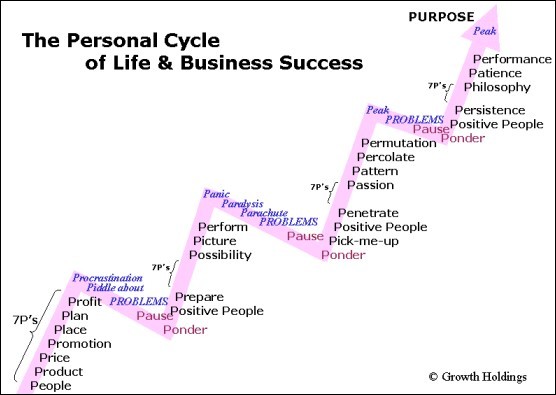
Almost every business career starts off with some initial training in the 7 Major P’s of any new business, product, or opportunity.
These cover an understanding of:
the People who are the potential customers;
the Product and its benefits to the consumer;
the Price which offers value and provides
a reasonable Profit margin for the success of the business;
the Promotion Plan which takes care of the marketing, advertising and distribution strategies and;
the Place – the location of retail outlets.
As I watch people leaving their first orientation training program on any new business or product, I note that their enthusiasm and excitement knows no bounds.
At that point they are convinced that what they have at their finger-tips is the greatest thing since peanut-butter.
Then something amazing happens.
Just when they’re at the very peak of their enthusiasm, they procrastinate!
They sit back and wait. They spend their time at home or in the office just piddling about, pretending that they are busy.
It is precisely at this point of the slippery slope that their minds turn to looking for problems to justify why they shouldn’t be leaving the safety and comfort of the office.
For one who understands these cycles, this is the point where one learns to pause.. and ponder what has got you to this first low point in your cycle of business success.
Whether you like it or not, everybody goes through these cycles. But most people do not understand this or recognize that such cycles actually exist, and they never get past this first low point.
Most job-hop to a new opportunity looking for a new trainer who will do a better job, little realizing that they are going to go through the same cycle all over again.
At this first low point in the cycle, I advise my delegates to get out and meet with the most positive people they know who are succeeding in business.
Now this is easier said than done, for there are very few genuinely positive people in life.
But when you do find them, they will confirm that you have to be totally prepared for success and they will get you to review your 7 Major P’s to try to understand why you were excited in the first place.
As you review your first orientation training program you will again sense the possibilities contained in the business opportunity.
You will soon develop a clearer picture of yourself being successful, and guess what, you even begin to perform and start selling your business concept to others with a measure of success.
However, it is just at this second peak of enthusiasm that panic strikes once again.
Someone asks a few smart questions that you can’t answer, someone criticises your product, someone questions your integrity, and paralysis sets in.
I’ve seen it time and time again.
People at this point find every excuse to stay at home or in the office.
Most people begin looking for a parachute to bale out.
And again they start focusing on all the potential problems to justify their inactivity.
Now here’s what’s exciting about understanding these cycles, when you start focusing on problems you know you’re almost at the end of your downward slide.
And now you know that, again, the only solution is to pause and ponder why you were enthusiastic in the first place.
By the way, whenever I have entered into this pause mode in the past, I would take the day off and relax alone on the beach, or paddle-ski in the surf, or play golf on a picturesque golf course, or just have tea and relax in a park.
Some of the nicest days of my life have been spent pondering my problems, and I’ve had many of these days.
This second low is easier to handle than the first, if you know that it is coming, and it IS coming, purely because you have your first low experience to go on.. and you have the experience to recognize that you came out of that with renewed enthusiasm.
You also know that you need a ‘pick-me-up’ and you’ve got to, again, search out those positive people who will remind you to review your 7 Major P’s.
In my experience, it is only after your third major review of your entire business that you start to develop a passion for what you are doing.
You also begin to realise that there is a pattern to this ‘success in business’ thing.
You’ve already come through two highs and two lows, and you have now noticed that, each time, the problems you were focusing on have diminished in importance.
And, you must also have noticed that the highlighting of problems is really the key indication that you are approaching your next low.
You also now know that you can take control over the length and depth of this low by pausing and pondering what is happening, and seeking the input of positive people.
It is when you realize that you have control over your response to these cycles that your passion for what you do begins to percolate.
Now you are operating with a permutation of three essential factors: knowledge of your business; passion; and personal power; which is when you begin to reach the peak of your performance in this exciting cycle.
You do know what’s going to happen next, don’t you?
Yes, new problems begin to appear once again.
You don’t feel like leaving home or the office.
What do you do?
You pause, you ponder, and you seek out positive people.
As you get through this third low, you are really beginning to learn one of the true secrets of success – Persistence!
So back you go to your 7 Major P’s.
President Coolidge once wrote: “Nothing in the world can take the place of persistence. Talent will not. Nothing is more common than unsuccessful men with talent. Genius will not. Unrewarded genius is almost a proverb. Education will not. The world is full of educated derelicts. Persistence, determination and hard work makes the difference.”
It is only at this point that you realize that your business career is really an extension of your personal philosophy in life.
This is where you develop the total belief that your product or service truly makes a meaningful difference in the lives of your customers.
Until you have reached this point you will never be successful in business.
With this level of confidence you develop the next most important trait for business success – Patience!
Patience with yourself, patience with your customers objections, and patience for the delay in the rewards that will eventually come from your increased performance in climbing to a new peak in your on-going cycle of business success.
My model of The Personal Cycle of Life & Business Success serves to remind everybody that the ultimate objective of every business career is, surely, to help you attain your true purpose in life.
Unless you know what your true purpose in life really is, you can never be truly happy in your business endeavors.
————————————————————————————————————–
Whilst my little model of The Personal Cycle of Life & Business Success clearly demonstrates that I place the focused, ACTION-oriented individual at the core of all business success, I should also point out that much of my corporate business expertise was gained in the listings, LBO’s and M&A’s boom in the second half of the ’80’s.
The ’80’s, for me, was the beginning of the serious development of PC-generated financial business models that led to almost instant analysis of traditional financial ratios: EY; DY; IRR; ROI; ROE; PE; Acid-Test; et al. These rapidly evolved into new financial models such as EVA; EBITDA and such like.
To get an idea of just what you can do with such financial models take a look at the 74 models on http://www.exinfm.com/free_spreadsheets.html .
Below is an extract snapshot graphic from this site.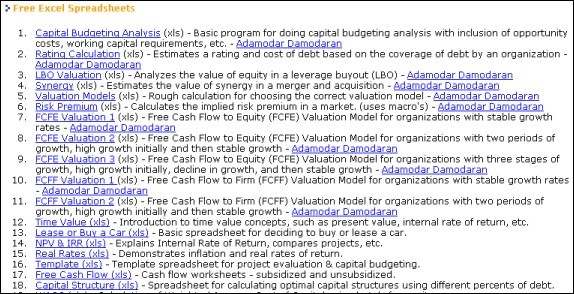
Oh yes, business consultants just love to play with the latest and greatest ‘Business Model’ doing the rounds.
As interesting as they might be to play with, I can’t shake my concern for thinking that the proficient builder of model-ships is hardly likely to be the one advising the skipper in command of a super-tanker in stormy seas, as it rounds the Cape of Good Hope.
So let me lay it straight on the line.
In my view, business models and tools are only useful when they serve to simplify one’s understanding of the goals established & challenges faced by a business, to identify alternative solutions, and to stimulate positive action to move forward with a clear strategy.
As a specialist business consultant however, I must admit to often testing the knowledge and strategic planning base of a CEO or senior management in the business by asking to see their:
1. Business Model
2. Profit Models
3. Cash Flow Models
4. Business Plan
More often than not, this request throws everyone into a spin, and if I am lucky I might get to view the last year’s annual financials or a copy of a business plan submitted to a financier.
So what’s the difference between a business plan and a business model?
A business plan can be 30, 40 50 pages or even more with pro-forma projections demonstrating the proposed roll-out of the business over the next 3 to 5 years.
A business model may consist of a maximum of 30 words, in flowchart format, often just on one page, giving an almost instant overview of the core business strategy.
Some call this a Strategy Map.
Much like a modern day mariner’s map charting their ships course to their next destination.
When the CEO produces this simple business model for me to view I know that they know something about their business!
Yet, it is when they produce their Profit Models for identifying the variables of their specific product lines that drive profit that I really know that we are dealing with a savvy management team.
I found a really useful e-book by an unknown author, through a Google search, who explains the concept of Profit Models with consummate ease.
I love the author’s description of the Profit Model as the ‘Swiss Army Knife’ of business.. because it just has so many excellent uses in setting revenue and expense targets, establishing sales prices, and for comparative analysis of margin and profit performance between periods.
This unknown author demonstrates a simple profit model example layout that can be followed by most businesses: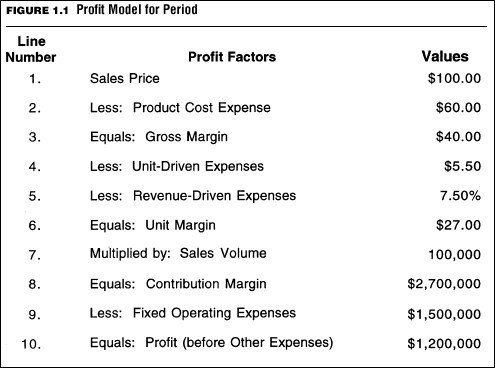
From this example it can be seen that the Profit Model focuses on the quantifiable specifics of achieving profits through a product line, whereas the Business Model focuses on the general direction of the business strategy.
Hopefully, so far, I am giving something of an indication that there are many, many ways for specialist business consultants to analyse a business, and also to apply any number of unique business models & tools that identify internal & external factors to help enhance business performance.
I have already mentioned in a previous chapter that I find myself somewhere in the middle of the Hersey & Blanchard Situational Leadership model, Steven Covey’s Principled Leadership value-driven model, Tom Peter’s ‘Pursuit of WOW’ proposals, and Zig Ziglar’s discussions on WIIFM (What’s In It For Me) in ‘See You At The Top’.
However, I must mention that I am really impressed with the work of Drs. Robert Kaplan & David P. Norton who created the Balanced Scorecard model in 1992. Their work finally began to bring together all of the key factors influencing business performance, taking account of a mix of financial and non-financial variables.
They identified leading indicators that can be of great use in forecasting the future health of a business.
The following graphic from http://www.balancedscorecard.org/basics/bsc1.html gives an interesting flow chart of the balanced scorecard model.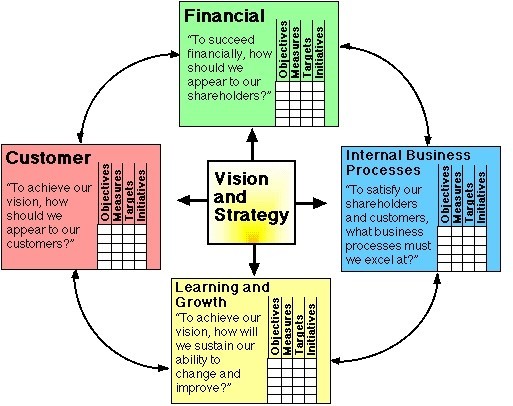
While on the subject of Drs. Robert Kaplan & David P. Norton, this interesting article on the ‘Net – ‘Beyond The Numbers’ – http://www.intelligententerprise.com/020726/512feat1_1.jhtml?_requestid=32417 – provides access to a stunning example of a quality strategy map developed by these two gents in 1997 to further enhance the understanding of their model: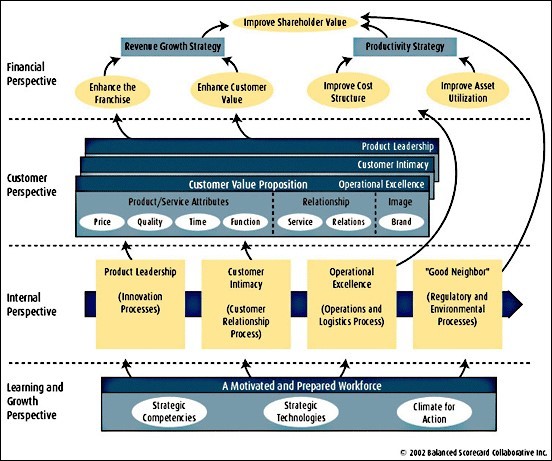
Perhaps the simplest tool of all, underutilized by most business decision makers in my view, is the simple PowerPoint software program by Microsoft – resident on most decision-makers PC’s.
I refer especially to PowerPoint’s Autoshapes facility, which allows for simple construction of Critical Path Analyses, Gantt Charts and Pert Charts, to name a few.
The following web graphic from http://quality.dlsu.edu.ph/tools/quality09.html demonstrates the symbols to be used in constructing a simple process flowchart: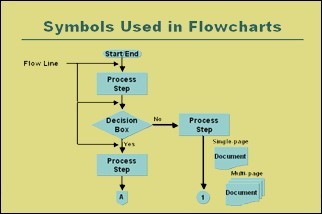
As does the following web graphic to be found on http://omarz.htmlplanet.com/INTRO_PROGRAMMING.HTM :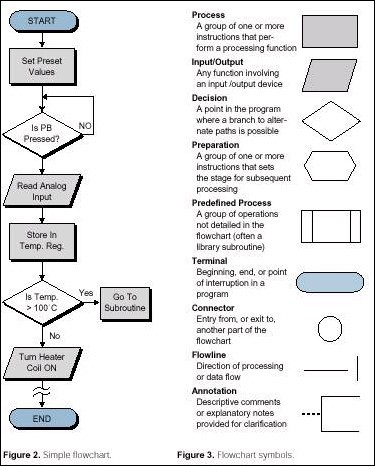
The developers at http://www.patton-patton.com/sample_charts.htm provide some excellent samples of flowcharts, org charts, and data flow diagrams produced by their software, such as this product development planning process flowchart:
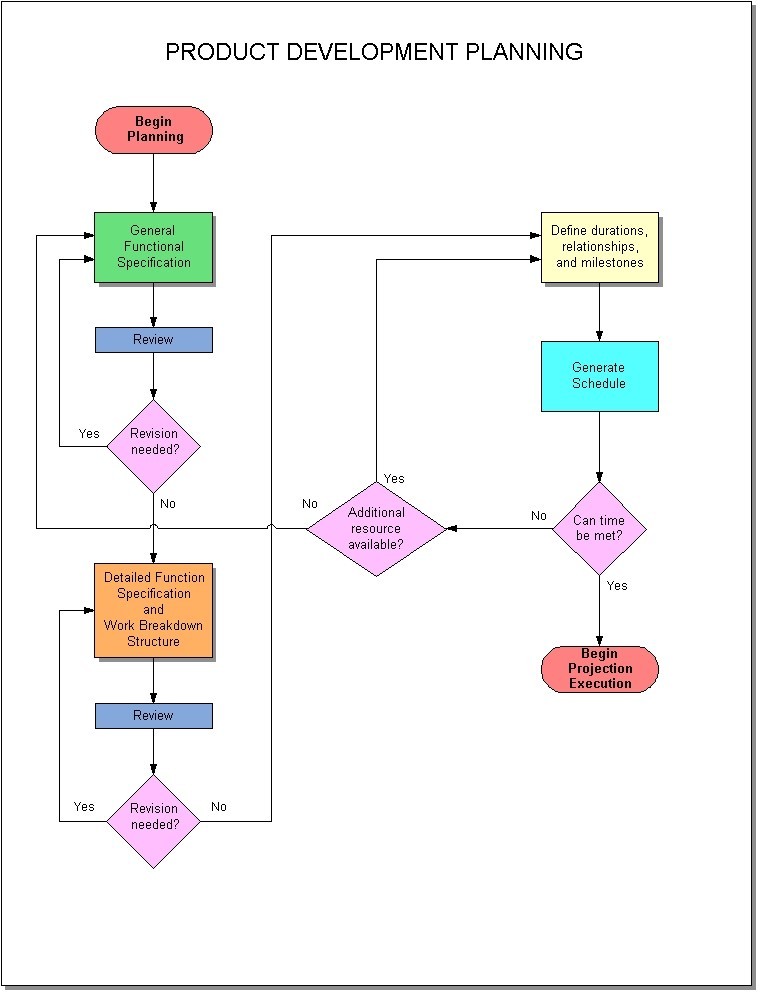
I also refer my delegates to http://www.smartdraw.com to access free trial software to test their flowchart construction skills and learn what software applications can do for a professional business consultant:

Oh my goodness, there are just so many great tools available to anyone who is excited about simplifying any aspect of the business process. Just get onto the ‘Net and Google for them.
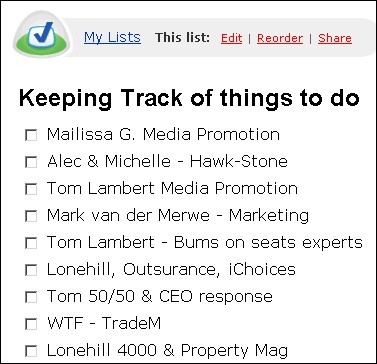
In closing this chapter, let me share with you the promising online application I use to take advantage of, perhaps, the simplest and yet most powerful of all business tools..the simple To-Do List.
Go along to http://www.tadalist.com/ and grab your own free online to-do list reminder facility like mine:
The logic is simple, you can have all the business models and tools in the world at your fingertips, but they will not help you a jot if you don’t put them into ACTION.. and just DO IT!
In Chapter 12. I introduce you to a sophisticated business strategy model that I developed for my own consulting business, back in 1990, and which seems to have stood the test of time for a decade and a half.
Simple ideas to grow your business
How you can DOUBLE your business income potential ..and more!
Back in 1990, after selling my shareholding and management control of the largest private sector education franchise in Southern Africa at the time – The Academy of Learning – into a JSE listed company, I formed my own Business Consultancy Group – Growth Holdings (Pty) Ltd.
I am extremely proud to say that Growth Holdings is now over 15 years old (written in 2005) and still going strong, having seen the most exciting of changes in South Africa during those times.
Notably the release of Nelson Mandela, the demise of apartheid, South Africa’s new democracy in 1994, and the acceptance of South Africa back into the real world economy.
Business survival during these uncertain times is certainly considered as no mean achievement, especially when taking into account Ann Crotty’s research – Business Report 9th March 2005 – declaring ‘about a 10 percent survival rate’ for businesses lasting on the JSE bourse from 1995 to 2005.
Yup.. let no one fool you.. being in business is TOUGH!
Michael Gerber – author of The E-Myth – first highlighted the fact that 80% of all small businesses fail in the first five years.
He stunned the business world by further showing that 80% of those remaining failed in the next five years.
Yes.. only 4% of small businesses survive past their first ten years!
Businesses that survive past ten years are the rare exception.
So what does it take to create a business that lasts longer than ten years?
Here are ten principles that I can share to grow a successful long-term business:
———————————————————————————————-
10 Principles To Grow A SUCCESSFUL Long-Term Business
1. Believe in yourself.
Entrepreneurs need to have unshakable self-confidence in their ability to motivate and inspire others to see their vision.
This comes from practical experience allied to an insatiable appetite for concentrated study of the most successful business people in the world and learning how they mastered their challenges.
2. Believe in your business.
A business can only profit if it delivers a product or service that consumers want.
Look for a way to add value to society and to make a positive difference in people’s lives.
Research the idea in the marketplace, test different marketing presentations, and guarantee your product.
3. Lay your body on the line.
Be willing to make personal sacrifices that ordinary mortals are not willing to make.
Conducting business with integrity and going out of your way to put your customer first are the rarest of observations in business today.
4. Be a decision-maker.
In a rapidly changing world where speed to market is critical, and where adverse trading conditions can hit in a matter of weeks, the ability to positively say ‘yes’ or ‘no’, with total confidence, is often the difference between success and failure in business.
5. Be prepared.
Know yourself, your personal goals, your business plan, market trends, local conditions, and be ready to evaluate and recognize opportunities as they arise.
6. Stay calm.
Every business will sail through troubled waters.
Business entrepreneurs who are prepared can keep their staff and consumers calm through the panic whilst leading the business to smoother waters.
Keeping cool in adversity comes from applying both learned knowledge and experience.
7. Be energized.
Everyone likes to deal with a winner. Keep fit, take regular, relaxing breaks, have fun, travel, maintain balance, and stay up to date and informed.
Be an advocate of health, motivation and fitness for everyone in your business.
8. Be a leader.
The whole world looks up to leaders.
Consumers want to be led on their purchase decisions.
Employees want to be led to success.
Study the principles of leadership and provide it in your business.
9. Be the best you can be.
You only live on this planet for a limited time. Spend it being the best you can be in your business and delivering service excellence every day.
10. Build a simple business system.
The secret of long-term business success lies in building a simple income-generating business system that works while you are away.. for a year or longer.
Make it a system that people can duplicate and trust in for potential franchising and investment possibilities.
———————————————————————————————-
Prior to, and during, those 15 years of driving Growth Holdings, I have had the privilege of building and analyzing many different businesses and organisations.
I have also passionately studied literally thousands of business books, magazines, articles and business models.
All these inputs from many masters have obviously influenced my own development and continual tweaking of a simple strategy matrix template tool (i.e. I make no pretentious claim to originality of any kind) that I follow to act as a simple HELICOPTER VIEW of the state of play in any business.
I call it: The GROWTH Business Strategy Matrix
This strategy matrix, for me, identifies and aligns the various stages of business that we tend to walk into when on a consulting project and gives an indication of what is needed to move most businesses from where they are to where they want to be.
That is, whether it be an urgent short-term crisis need for revenue income, or a desire to create a solid strategy foundation platform for focusing on long-term planned sustainability and profit.
The key to this matrix is its modular sequencing, allowing one to identify highly critical phases in any business, and is most effectively demonstrated to my seminar delegates by means of PowerPoint Slide Show allowing each module, segment or grid to phase sequentially into the overall matrix.
That being said, it is important to understand that no particular grid on the matrix has any priority over another in ANY business. The sequencing of the presentation has merely evolved from the most common occurrences we have noted when called in to assess a business project.
It bears repeating my mantra that every business and every business problem is, or should be, considered unique.
No two business challenges are ever the same in any business.
They always have different input factors, different people relating to those factors, different environments, which make up the unique nature of each business problem.. requiring a unique solution.
So, in our seminars, we begin to dissect the critical phases of any business by introducing the sequential constructs of our strategy matrix.
The Helicopter View allows us to fly so high above the business landscape that we are all reminded of the two key business issues that business leaders are faced with.
Anyone who recalls the September 11th terror attacks (and who, having witnessed the visuals, will ever forget that most tragic of days) that obliterated so many innocent lives in the World Trade Center buildings, will testify to the almost instantaneous and devastating affect of External Factors.
Economic, political, environmental events and market competition can all combine and contribute to massive changes in customer behavior.
As if watching out for the sky to fall in is not enough, business leaders also have to deal with the Internal Factors that affect the performance of their business.
Every day there are people issues, production challenges, financial constraints, legal issues, business relationships, ethics, compliance.. you name it, the business leader and manager is saddled with it.
So the slides begin:
Slide1.
The unfolding matrix begins by clearly highlighting the point that business is driven by keeping an eye on two core fundamentals:
a. External Market Disciplines – what you have to do and consider to attract and win the attention of customers from the eardrum-shattering noise of a vast universe of competition for their hard-earned buck.
b. Internal Growth Disciplines – what you have to do inside your business to create a product and service Value Chain that offers exceptional customer benefit.
Slide2. Grid 1.
This grid highlights the boiler-room of the business, where the fires of the revenue-generating furnace have to be stoked continually to white-hot levels to drive the bottom-line.
Profit, after all, can only come from increasing revenue, or decreasing costs, or some combination of these two factors.
Almost all business leaders, business troubleshooters and turnaround specialists will instantly recognize the poignancy of Grid 1.
More often than not, business consultants are called in to address problems in this grid, at precisely the WORST phase in the most difficult times of a business cycle.
That is, when revenue has taken a dramatic dip, and the company’s stocks and prospects are tumbling alarmingly south.
This is the most dangerous time for any consultant to enter into the fray and many end up being dragged onto the rocks by a project that is just too far gone to save.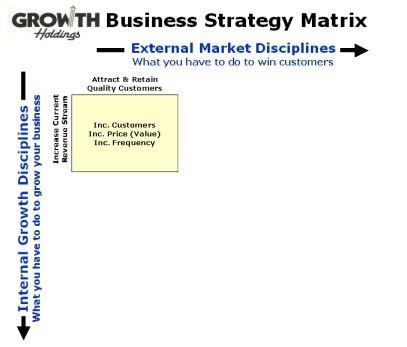
However, this is also the time that super-consultants become famous as the ‘white-knights’ who stimulate major change and ‘rescue’ companies from impending doom.
For them, this is the grid where the rubber has to hit the road instantly by taking no-nonsense actions to generate revenue.
Actually, the good news for any business leader is that there is no need for them to get to any such terrible doomsday scenario, simply by keeping a constant eye aware of what is happening to keep the revenue-generating furnace burning white-hot.
I have already mentioned Jay Abraham in this publication as one who truly understands the 3 Keys to generating increased revenue in any business, which are worth repeating here:
1. ..by bringing in NEW customers;
2. ..by ADDING VALUE to your products and increasing their average selling price; and
3. ..by getting your OLD customers to purchase more frequently.
This is also the grid where Customer Relationship Management (CRM) earns it stripes as a business process.
It is where managing the Customer Experience comes from clearly understanding the customer’s Lifetime Customer Value (LCV) to the business.
Lifetime Customer Value recognizes that it is considerably more advantageous and profitable for a business to keep a quality client returning to repeatedly purchase products and services regularly, for as long as possible, as this process is far more cost-effective than the cost of wooing new customers and then losing them.
Jay Abraham, it was, who again who had me marveling at the simple maths that can be employed to unveil the amazing geometrics of business.
I recall learning from his work that a relatively small improvement of just 10% in the amount a customer spends, with a 10% improvement in the lifetime spent buying from the business, with a 10% reduction in the time between purchases, will result in a neat 34.4% increase in revenue per client.
For me, making the commitment to understanding the Lifetime Customer Value of business customers indicates a strong desire by business leaders to organize their business to service the customer profitably.
With that attitude they will avoid their business getting into serious trouble in Grid 1.
Slide3. Grids 2&4.
The FUN part of business strategy begins to unfold for our delegates as Grids 2&4 slide simultaneously into view.
The point intended, by bringing them onto screen simultaneously, is to keep underscoring the importance of keeping an eye on both external and internal factors critical to long-term business sustainability.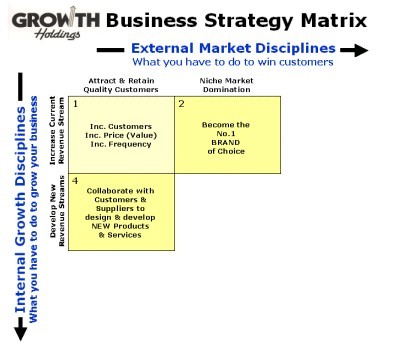
Grid 2. highlights the importance of differentiating your business from everyone else.
It is about what makes you unique, your USP, and the strategies needed to become the No.1 brand of choice in the market niche you want to dominate.
The study of trademarks and brands in building a business is fascinating research, and tons of material is available on these topics. However, I am very excited about the direction being taken by Kevin Roberts – CEO of Saatchi & Saatchi – who today travels the world promoting the concept of brands as ‘Lovemarks’ (see www.lovemarks.com ).
Says Kevin: ‘Lovemarks are the charismatic brands that people love and fiercely protect. They inspire loyalty beyond reason.’
I love the concept!
Grid 4. unfolding on screen at the same time as Grid 2. reminds one to constantly consult with key business stakeholders, and that means EVERYONE that has a stake in your business – your customers, your people, your shareholders, your suppliers, your bankers – to identify opportunities for developing new revenue streams, new products or improvements to current products.
As critical and FUN a process that this is, too few business enterprises enter into the true spirit of collaboration with their customers and suppliers, thereby missing an immensely enriching and rewarding experience for all those involved in the process.
It is perhaps one of the simplest ways to build a ‘lovemark’ that inspires irrational customer loyalty.
Slide 4. Grids 3, 5, & 7.
For the Business Development Strategist, and for any serious business leader or specialist business consultant for that matter, the simultaneous sequence of Grids 3, 5 & 7 onto the screen highlights an entry into the process of confirming and ensuring the long-term sustainable growth phase of any business. It indicates a high level of business leadership maturity.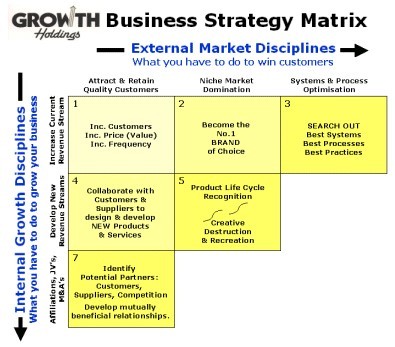
In this simultaneous sequence of 3 Grids we are reminded first, by Grid 3, that business is all about quality systems and processes and how they facilitate the efficient movement of the product through the Value Chain, from concept or raw material stage, into the hands of the customer.
Grid 3 indicates that ‘Best Practice’ is the cornerstone of the business re-engineering process, and is most often conducted by business leaders and managers in consultation with specialist business consultants skilled in the selected best practice.
Technological advances and innovations ensure that savvy business leaders will always have to keep a sharp eye out for new Systems, Processes and Practices.
Determining ‘Best Practice’ generally includes four key steps: Current State Assessment, Benchmarking, Cost Benefit Analysis, and Revising the Process. Each topic covered in enough business books to fill countless libraries.
Grid 5, flowing onto the screen simultaneously, and perfectly positioned as the central Grid in the matrix, reminds us that all good things go through similar cycles of introduction – growth – maturity – decline, whether it be individual product lines or the business itself.
In today’s rapidly changing times, with massive technological and quality innovations happening every day, product life cycles are shrinking at the same time as are product operating life times increasing through increases in quality and value demanded by consumers, resulting in a profit squeeze in almost all businesses.. and a decrease in the time available to secure a decent return on investment (ROI).
Joseph Schumpeter it was who first recognized the concept of ‘creative destruction’ in which the very innovative nature of business entrepreneurs creates instability in markets causing existing businesses to adapt their processes or die.
This Grid emphasizes the critical importance of being ahead of this ‘natural’ innovative business and market process curve, and is underscored by rapid technology advances happening daily, at the blink of an eye.
It means maybe having to break what ain’t broke.. a fearful process for most in business!
Along with Grids 3 & 5 slips Grid 7, the favored realm of corporate listing specialists, and those who look to derive exponential synergies from mergers & acquisitions when building the asset base of a budding conglomerate to ready it for public equity listing.
For business leaders intent on keeping their organisations private, this is the time to utilize affiliation and joint venture specialists to identify potential partners, customers, suppliers, and yes.. competitors, within whose business processes mutually beneficial relationships can be developed.
Slide 5. Grids 6 & 8.
These two Grids slide simultaneously onto the screen to remind us of the critical need for constant INNOVATION within a strategic business planning process.
Grid 6 highlights the importance of assessing consumer behaviour patterns as well as mining for new opportunities within your own customer database.
Searching for improvements in Value Chain efficiencies to enhance customer value and testing for market acceptance are critical components of this grid.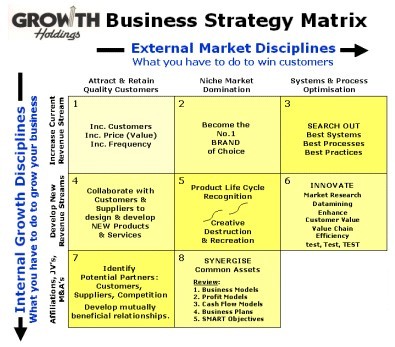
Grid 8 serves as a reminder to constantly apply and review the many business models and profit-drivers discussed in this publication.
Slide 6. Grid 9.
Finally, current pride of place on the ever-evolving Growth Business Strategy Matrix goes to.. the Balanced Scorecard model.. the work of Drs. Robert Kaplan & David P. Norton.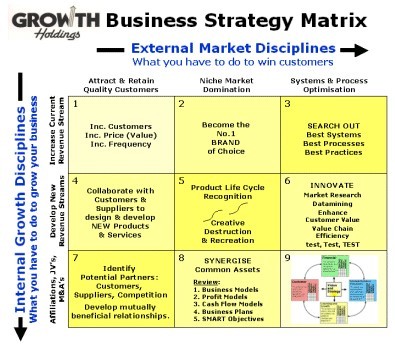
I like to link to the graphic on http://www.balancedscorecard.org/basics/bsc1.html for display in Grid 9 to serve as a continuing reminder to bring together all of the key factors influencing business performance, taking account of a mix of financial and non-financial variables.
Kaplan & Norton identified leading indicators that can be of great use in forecasting the future health of a business, and developed a process for allowing specific initiatives, objectives and targets to be set and measured for results or change.
The Balanced Scorecard model is a fantastic tool for monitoring all serious business operations and is a magnificent aid to monitoring a helicopter view of business.
______________________________________________________________________
Wrap Up. Well, There You Have it Then!
As we come to the end of my first simple compilation of the thoughts and experiences that go through my mind when consulting to others in business, I sincerely hope that you have been stimulated to delve further into the areas of business that excite you.
For the business leader, manager, decision-maker, specialist business consultant, and anyone interested in any area of business, it should be clear from my constant opinion expressed in this publication that I believe that no two business operations, and no two business challenges, are ever the same.
Clearly that means that there are an abundance of incredible opportunities available to anyone prepared to major in the study of business, and then, to those who will have the courage to apply what they have learnt, tweak them a little with their own innovations, and test their ideas in the real world.
After 30 years of my own experience in business, having spent a fortune on purchasing books and magazines, I am today blown away, every day, by the amazing amount of information that we are able to access over the Internet, as shared by many of the world’s most successful people in business.
And, don’t get me wrong, it is just not the famous business gurus that one can watch and learn from on the ‘Net, as exciting as that is.
More exciting to me is that I can’t help feeling that the world’s top 10 business billionaires in the 2020’s, 30’s and ‘40’s are busy making their comments, asking their questions and sharing their ideas somewhere on the Web.. right now!
With so many people all over the world being so blessed with almost unlimited access to an abundance of information on almost any area of interest under the sun, there seems to me to be no reason to ever be at a loss for something to do, especially in the world of business.
I have one wish, and that is that everyone so blessed determines to find a way, no matter how small, to SHARE the simple things that excite them about business, and especially to share access to information, with those who do not have it.
Now, it’s back to work.. I must confess that I am a SERIAL Entrepreneur.
